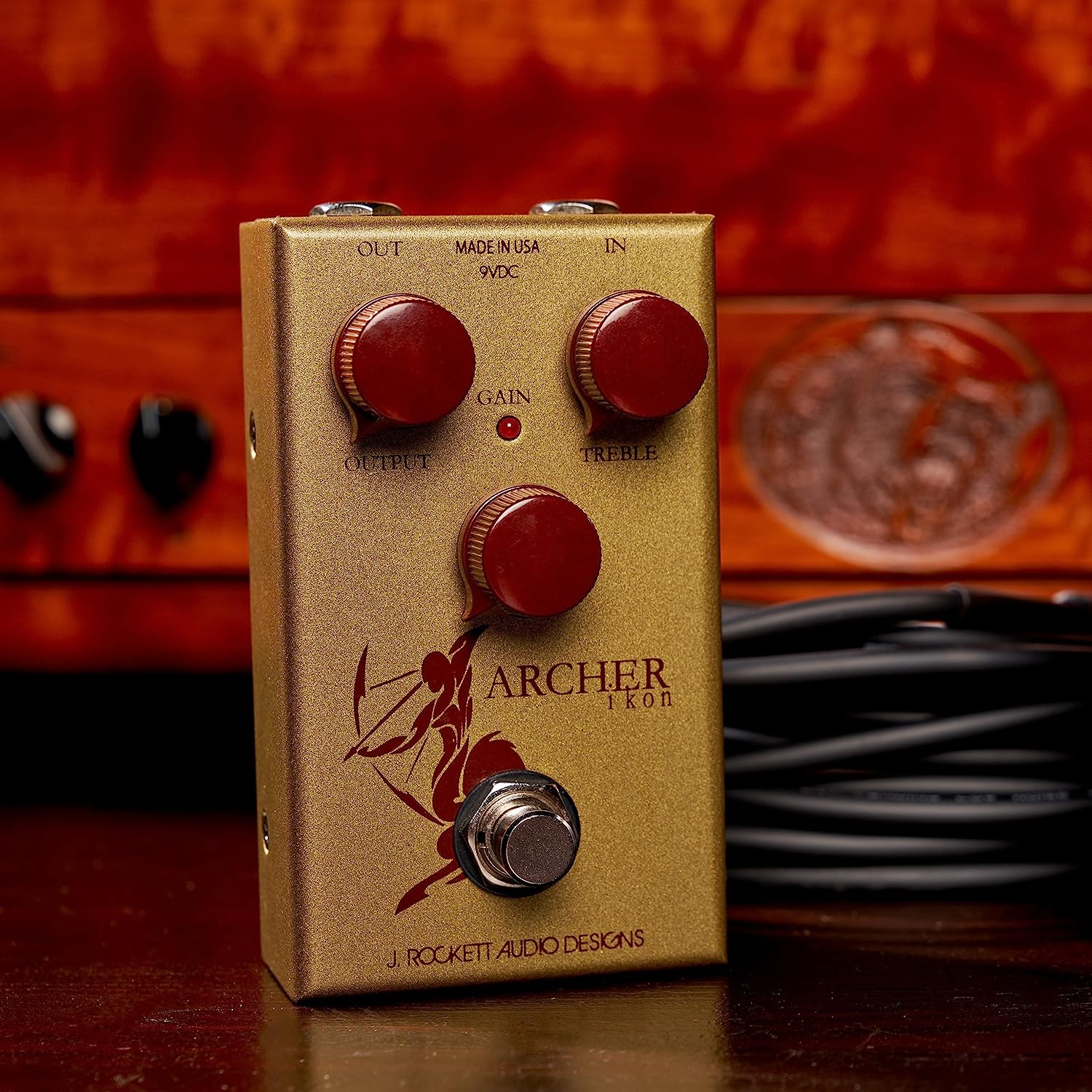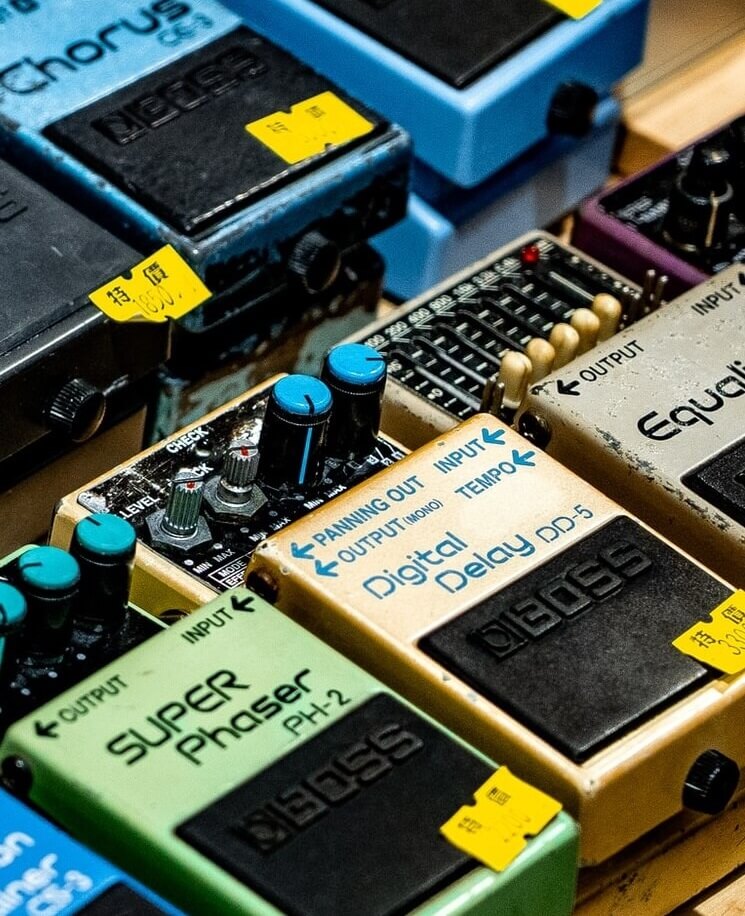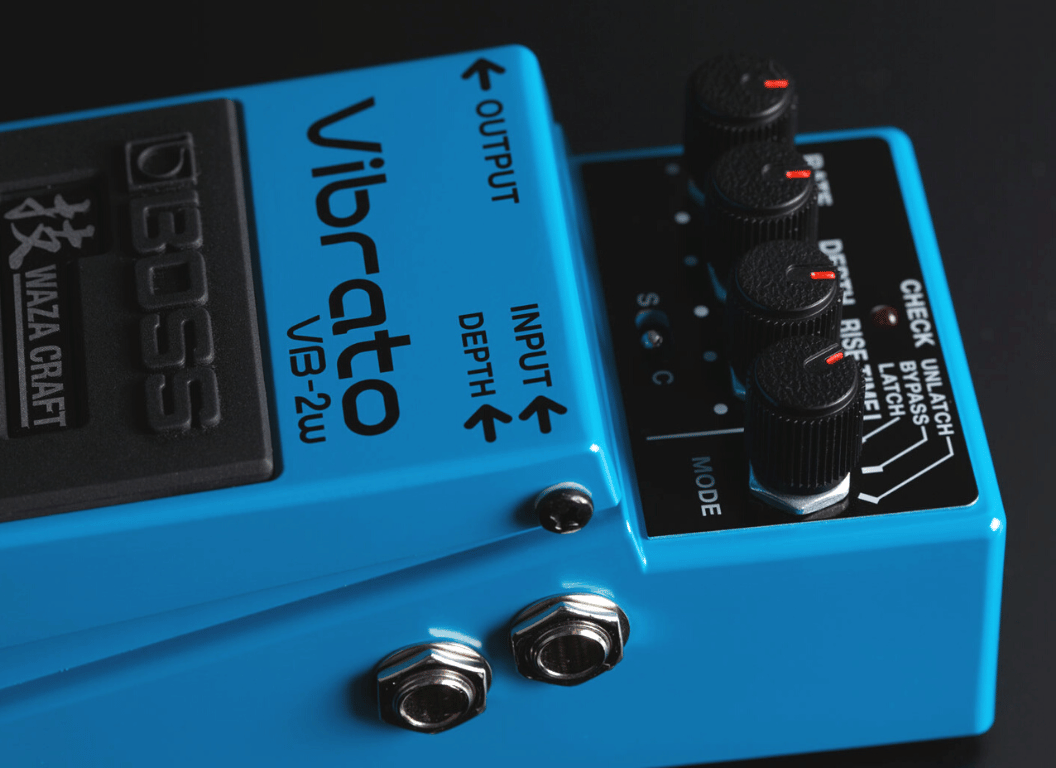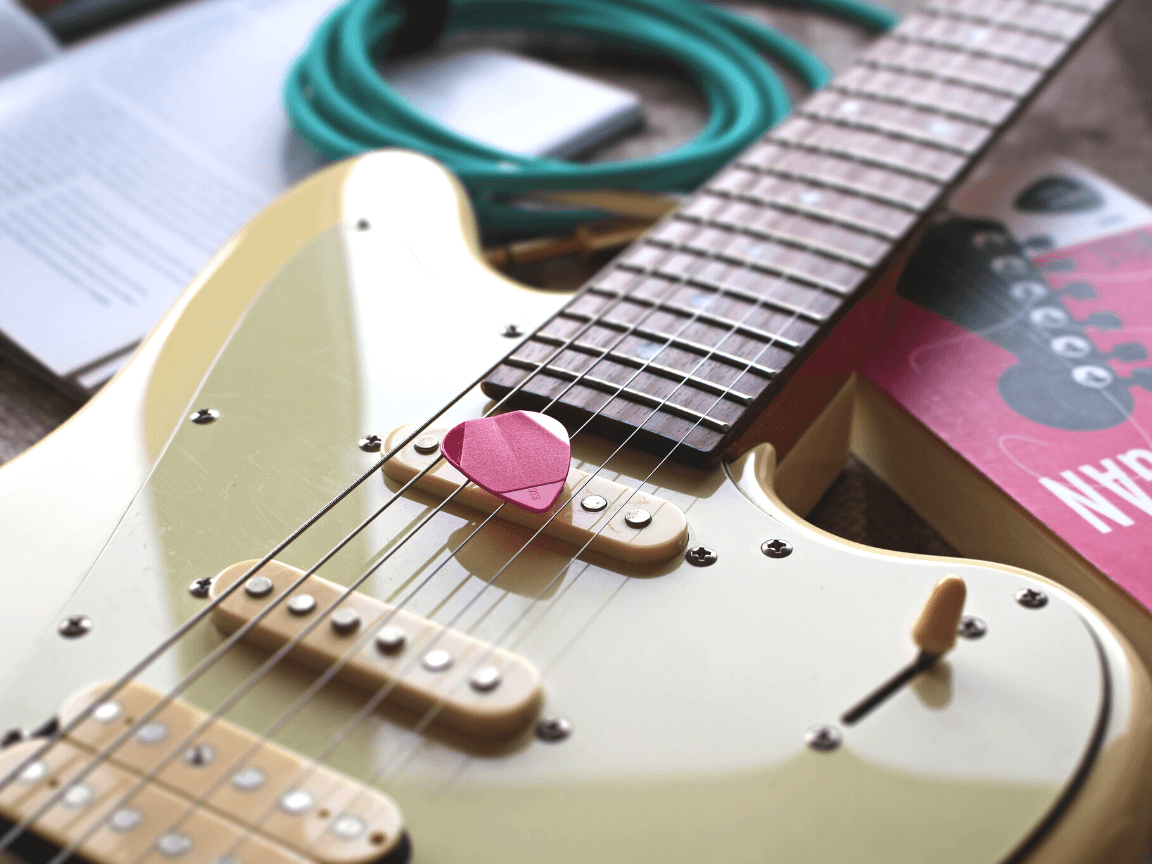Are ychou struggling to cut through the mix in your band? Or are you tired of always getting lost in the wall of sound?
In this blog post, we’re diving deep into the world of boost pedals, your secret weapon for a more commanding, defined tone.
We’ll explain why these unassuming pedals are a must-have for any serious guitarist, bassist, or keyboardist and how they can transform your live and studio performance.
As such, with this comprehensive guide on the best boost pedals in the market today and top tips for making the most of them, you’ll hit all the right notes in no time.
Table of Contents
- Best Boost Pedals
- Walrus Audio Emissary Parallel Boost Pedal
- JHS Prestige Boost Guitar Effects Pedal
- MXR M-133 Micro AMP Pedal
- MXR Booster Mini Guitar Effects Pedal
- J. Rockett Audio Designs Boost Pedal
- Ibanez Tube Screamer Mini Pedal
- VSN Guitar Booster Effect Pedal
- Xotic EP Booster Mini EQ Effect Pedal
- NUX Lacerate Mini Booster Guitar Boost Pedal
- Jim Dunlop Boost/Line Driver Pedal
- Electro-Harmonix LPB-1 Linear Power Booster Pedal
- Wampler Decibel Plus V2 Pedal
- Keeley Mini Katana Clean Boost Pedal
- MXR Timmy Guitar Effects Pedal
- EarthQuaker Devices Arrows Booster Pedal
- Fender Engager Boost Pedal
- TC Electronic SPARK Mini Booster Pedal
- What exactly is a boost pedal?
- What to consider when choosing a boost pedal?
- How to properly use a boost pedal?
- – Familiarize yourself with the controls and features
- – Adjust the parameters to suit your musical goals
- – Incorporate the boost pedal into your signal chain
- – Utilize the pedal to achieve specific tonal effects
- – Combine with other effects pedals for enhanced textures
- – Practice playing dynamics with the boost engaged
- – Maintain and troubleshoot your boost pedal for optimal performance
- How to order pedals on a pedalboard?
- Boutique vs. Mass-Produced pedals
- How much should you spend on a guitar pedal?
- Can you use a guitar pedal with a bass guitar?
- How to properly power your pedals?
Best Boost Pedals
Before I begin, here are my top selected choices:
MXR Booster Mini Guitar Effects Pedal

Compact, powerful MXR boost pedal with Echoplex Preamp and +25dB signal boost. Check Price
|
|
Electro-Harmonix LPB-1 Linear Power Booster Pedal

Boost your sound with the LPB-1 Preamp Pedal. Check Price
|
Walrus Audio Emissary Parallel Boost Pedal
Delivers clean, high headroom boosts with selectable frequencies for maximum tonal versatility.
Walrus Audio offers a range of high-quality power supplies and pedals, featuring clean isolated power and targeted boosts to give your tone a sinus-clearing experience. Their products are designed to provide the purest sound in your signal chain, with convenient and easy to use controls. Their illustrator-designed finish adds a unique visual touch to any pedalboard.
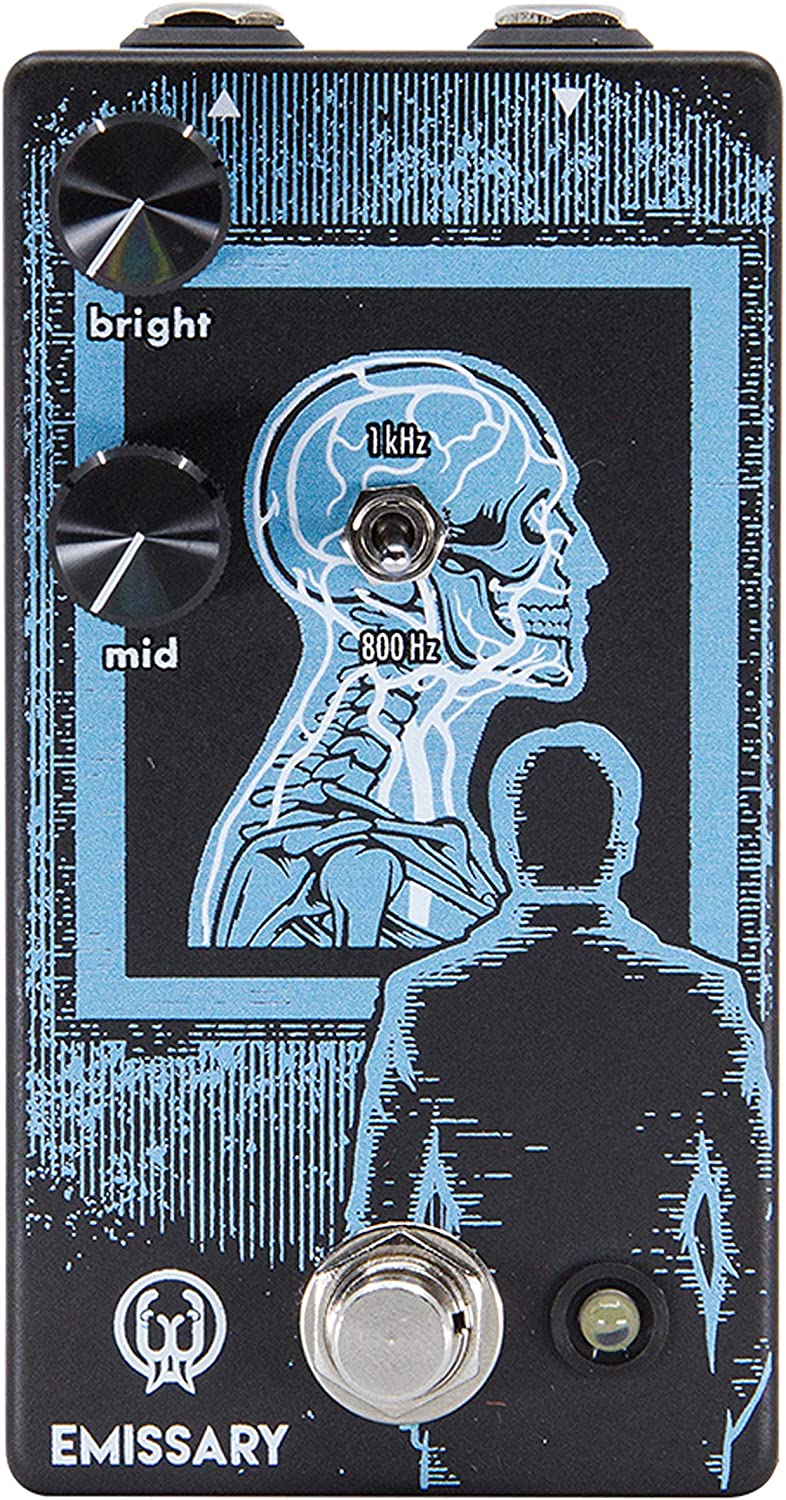
Meet the Walrus Audio Emissary, a parallel boost guitar effects pedal designed to elevate your music performances.
Its dual-boost feature can make your solos shine, resonate with your slide guitar, and vibrate your fingerpicking styles.
It’s not just a volume booster; it’s more about fine-tuning your sound.
Two distinct knobs govern its operation: one regulates a “bright” boost circuit, which provides a high headroom JFET boost with a slight lean towards higher frequencies.
This way, it breathes new life into your tonal palette.
Meanwhile, the second knob modifies the “mid” boost circuit, delivering a focused boost at either 1kHz or 800Hz, as determined by the toggle switch.
An interesting feature of this pedal is its momentary function, letting you activate the effect temporarily by pressing and holding the bypass switch and turning it off by simply releasing it.
In addition, the pedal showcases a stylish “Silk satin black” finish and unique artwork from illustrator Adam Forster, presenting an intriguing X-ray view of a patient’s skull with the emissary’s vein.
- My Review
This parallel boost guitar effects pedal is no ordinary volume booster.
Instead, its magic lies in its versatility and the depth of customization it offers.
First, let’s talk about the dual-boost feature.
It’s simply ingenious, allowing you to make your solos stand out.
Add to that the capacity for slide guitar to ring out with more resonance and for fingerpicking styles to take on a new vibrancy, and you have a pedal that’s a genuine game-changer.
I found the “bright” boost circuit to be an exciting addition.
It provides a high headroom JFET boost that does overall favor higher frequencies.
It’s a subtle effect, but its impact on livening up your tonal palette is far from insignificant.
Turning the dial to the second knob, which controls the “mid” boost circuit, makes things interesting.
This provides a precise boost at either 1kHz or 800Hz, depending on your preference, as set by the toggle switch.
And what a difference it makes!
What’s particularly noteworthy about this pedal is its innovative momentary function.
This allows you to activate the effect temporarily by holding down the bypass switch, then turning it off just by releasing it.
These smart, intuitive design features make the Emissary so much more than just a pedal.
Then there’s the aesthetics – that “Silk satin black” finish is as sleek as possible.
And the artwork by illustrator Adam Forster, showing an X-ray of a patient’s skull with the Emissary’s vein, well, it’s not just intriguing, it’s a conversation starter!
However, it’s not all sunshine and roses.
Here are the ratings I’ll give to the Walrus Audio Emissary Parallel Boost Pedal:
Considering the use of SMT components, the price point feels a little steep, which might not appeal to some purists.
But if you’re all about the music and the potential to redefine your sound, the Emissary might be the pedal you never knew you needed.
- Pros:
- Great for driving amp speaker
- Versatile 2-in-1 boost for various tones
- Allows mix and match of boost circuits
- Momentary function for temporary activation
- Cons:
- May not be necessary if you don’t need a boost pedal
- Price may be considered high for some
My final verdict is that the Walrus Audio Emissary Parallel Boost Guitar Effects Pedal is a versatile and feature-rich pedal that delivers excellent tone and performance.
Its dual boost circuits and the ability to mix and match offer flexibility for different playing styles.
The momentary function adds a useful touch to its functionality.
The positive reviews highlight its capability to drive amp speakers effectively.
While it may not be necessary for everyone, and the price could be a consideration, the overall brand reputation is strong.
Considering its performance and features, the pedal offers solid value for guitarists seeking to enhance their tone.
JHS Prestige Boost Guitar Effects Pedal
Unique booster/buffer for long cable runs and natural overdrive.
The JHS Prestige boosts your signal to produce natural overdrive, perfect for solos or for adding extra saturation. Its one volume knob allows for a buffer/enhancer, volume boost, or an amp-pushing natural breakup. It’s the perfect addition to any guitar rig.
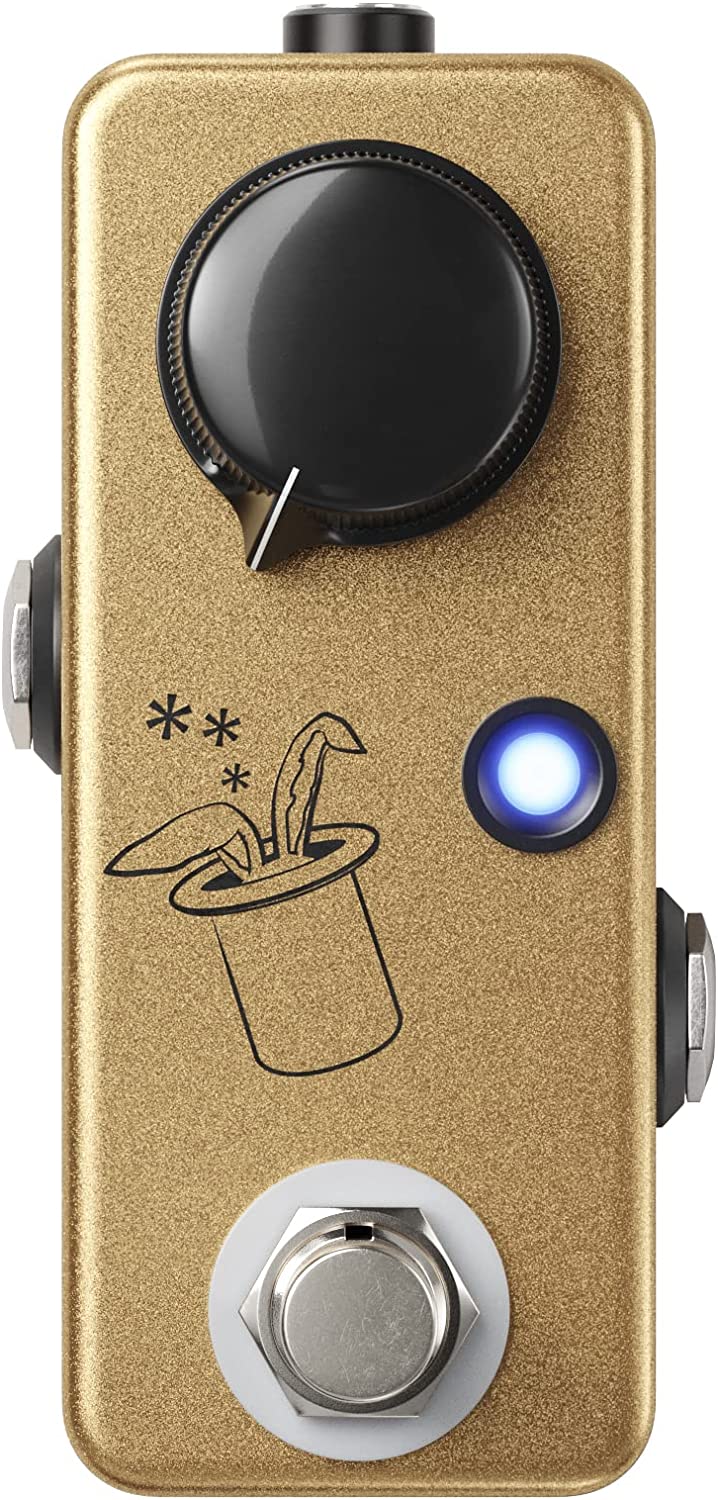
Looking to add a bit of magic to your guitar sound? Check out the JHS Prestige Boost Guitar Effects Pedal.
This pedal is designed with a single knob that serves multiple purposes.
In its initial range (up to 25%), it functions as a buffer and enhancer, perfect for maintaining signal quality over long cable runs or adding a dash of brightness to your sound.
Crank it up to the mid-range (25% to 75%), transforming it into a volume booster, delivering that extra push you need for stand-out solos, or adding an extra layer of saturation to an overdrive.
Above 75%, the pedal shines by overdriving your amp into a naturally rich breakup, providing a versatile first or second-stage overdrive.
This handy, gold-colored tool, crafted by JHS Pedals, is compact (measuring 6 x 3 x 3 inches and weighing only 210 grams) and operates on standard 9V DC negative power.
- My Review
Right off the bat, I must commend the JHS Prestige Boost Guitar Effects Pedal for its simplicity and elegance.
One look at this pedal, with its sleek gold finish, and you know it means business.
Moreover, it’s compact and lightweight, making it a breeze to transport.
Its singular control knob is what truly sets it apart.
No fussing over countless settings, just one knob to rule them all!
Initially skeptical, I wondered if one knob could handle everything from buffering to boosting.
But boy, did it deliver!
In its initial position, it played the role of a buffer and enhancer beautifully.
It retained my guitar’s natural sound quality even over long cables and added a welcome touch of brightness.
It felt like the perfect tool for those jam sessions where you need that extra reach.
As I nudged the knob past the 25% mark, the pedal morphed into a versatile volume boost, handing me that extra punch for dynamic solos.
Coupling it with an overdrive pedal yielded some satisfyingly saturated tones, adding the right amount of grit to my sound.
But the real game changer was when I cranked the knob beyond the 75% threshold.
This sent my amp into a deliciously warm and natural overdrive, creating a tone that was as meaty as authentic.
In addition, the pedal’s flexibility as a first or second-stage overdrive was impressive, maintaining my original tone’s character while offering just a bit more of what I love.
My only critique is the power requirement – it uses a standard 9V DC negative power, but an included adapter would have been a nice touch.
Here are the ratings I’ll give to the JHS Prestige Boost Guitar Effects Pedal:
In essence, the JHS Prestige is a well-crafted, multi-purpose tool delivering impressive results with remarkable simplicity.
So if you’re looking for a pedal that offers a range of effects with minimal fuss, this might be the one to add to your rig.
- Pros:
- Compact and portable design.
- Versatile functionality as a booster, buffer, or enhancer.
- Ability to create natural overdrive.
- Easy-to-use volume knob for control.
- Cons:
- May not provide extensive customization options.
- Requires a standard 9V DC negative power source.
My final verdict is that the JHS Prestige Boost Guitar Effects Pedal is a highly versatile and feature-packed pedal that offers excellent tone and performance.
Its ability to function as a booster, buffer, or enhancer gives musicians flexibility in shaping their sound.
The brand, JHS Pedals, is well-known and respected in the industry, and the pedal offers good value for its price.
Overall, the JHS Prestige Boost Guitar Effects Pedal is a solid choice for guitarists looking to add a touch of magic to their rig.
MXR M-133 Micro AMP Pedal
Boost your signal with MXR’s Micro Amp Bundle.
The EMG Micro Amp is a simple yet effective booster for your guitar signal, providing a preset amount of gain with one control. It can also be used to adjust between two guitars with different outputs or to combat signal drop off in a long effects chain.
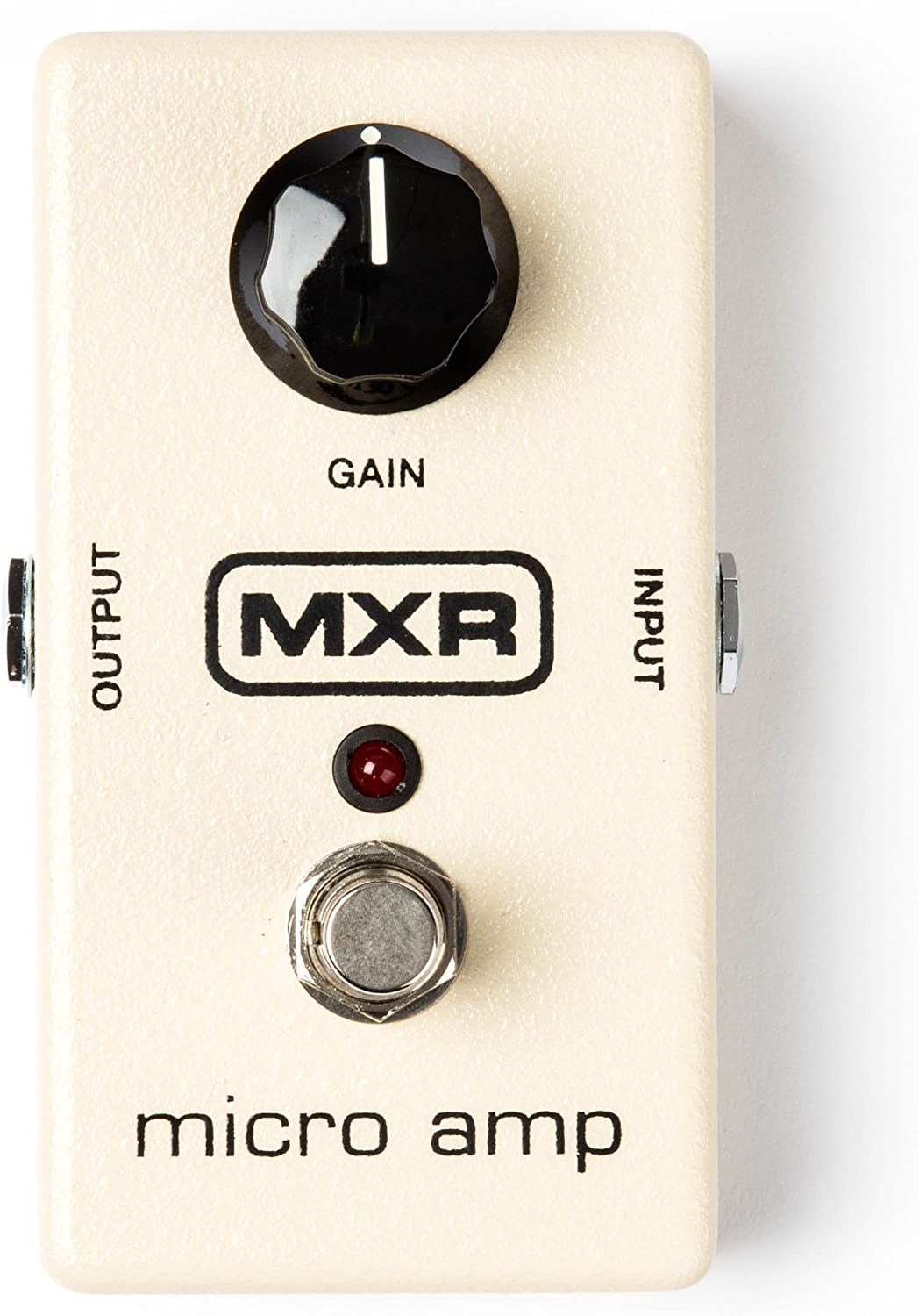
This compact MXR M133 Micro Amp Booster Effects Pedal is truly a marvel for musicians, especially when you need that extra punch for your lead performances.
One control brings in a preset gain, making it perfect for easily switching between two guitars with different output levels.
Have you ever faced issues with a signal dropoff in a long chain of effects?
This pedal offers a permanent solution by consistently boosting your signal.
It comes in a bundle with a 9V power supply and six varied Dunlop guitar picks to sweeten the deal.
Powering the pedal is effortless with its included AC/DC adapter.
With a stylish, assorted color design and an efficient power source, this bundle is more than just a pedal—it’s a comprehensive solution for guitarists.
So whether you’re jamming on humbuckers or single-coils, this versatile little device enhances your performance.
- My Review
I’ve got to say the MXR M133 Micro Amp Booster Effects Pedal has truly risen to the occasion.
As a simple, powerful tool in a guitarist’s kit, it impressed me with its single control gain boost.
No frills, just a pure, straight shot of gain whenever I needed it.
Speaking of convenience, I marveled at its ease when switching between two guitars with different output levels.
Whether I was strumming away on humbuckers or single-coils, the Micro Amp gracefully adjusted the signal strength, ensuring smooth transitions without any hiccups.
That’s what you call a true game-changer.
Now let’s talk about the pedal’s real star quality – its ability to handle signal dropoff in a long chain of effects.
Plenty of pedals falter here, but the Micro Amp held its ground, constantly keeping the signal robust.
That’s not just brilliant; that’s practically indispensable!
I appreciated the 9V AC/DC adapter when powering this little beast.
No running around hunting for the right power source.
They even tossed six assorted Dunlop picks in the bundle – a cherry on top!
Despite the Micro Amp’s near-perfect performance, I noticed it slightly darkening my amp’s natural sound.
It’s a minor issue, barely noticeable, but being a bit of a purist, it did catch my attention.
However, considering the versatility and control this pedal offers, that’s a trade-off I’m willing to make.
- Pros:
- Transparent sound
- Works as described
- No signal or volume loss
- Effective for solos
- Cons:
- Potential lack of versatility
- May not suit all musical styles
My final word on the MXR M133 Micro Amp?
It’s a solid piece of gear. It steps up, does its job, and then some. It doesn’t just push your amp – it takes your sound to a new level.
Here are the ratings I’ll give to the MXR M-133 Micro AMP Pedal:
My final verdict is that the MXR M133 Micro Amp Booster Effects Pedal is a highly regarded product with positive reviews and a solid reputation.
It offers transparent sound, works as described, and provides a boost without signal or volume loss.
While no negative reviews are available to highlight any potential drawbacks, it’s important to note that versatility may vary depending on individual musical styles and preferences.
Overall, the pedal has been positively received and offers good value for those seeking a reliable boost for their guitar signal.
MXR Booster Mini Guitar Effects Pedal
Compact, powerful MXR boost pedal with Echoplex Preamp and +25dB signal boost.
MXR is a top brand of effects pedals, delivering reliable and classic sounds. Their pedals are designed to last, with a range of distortion, overdrive, boost, wah, and modulation effects available.
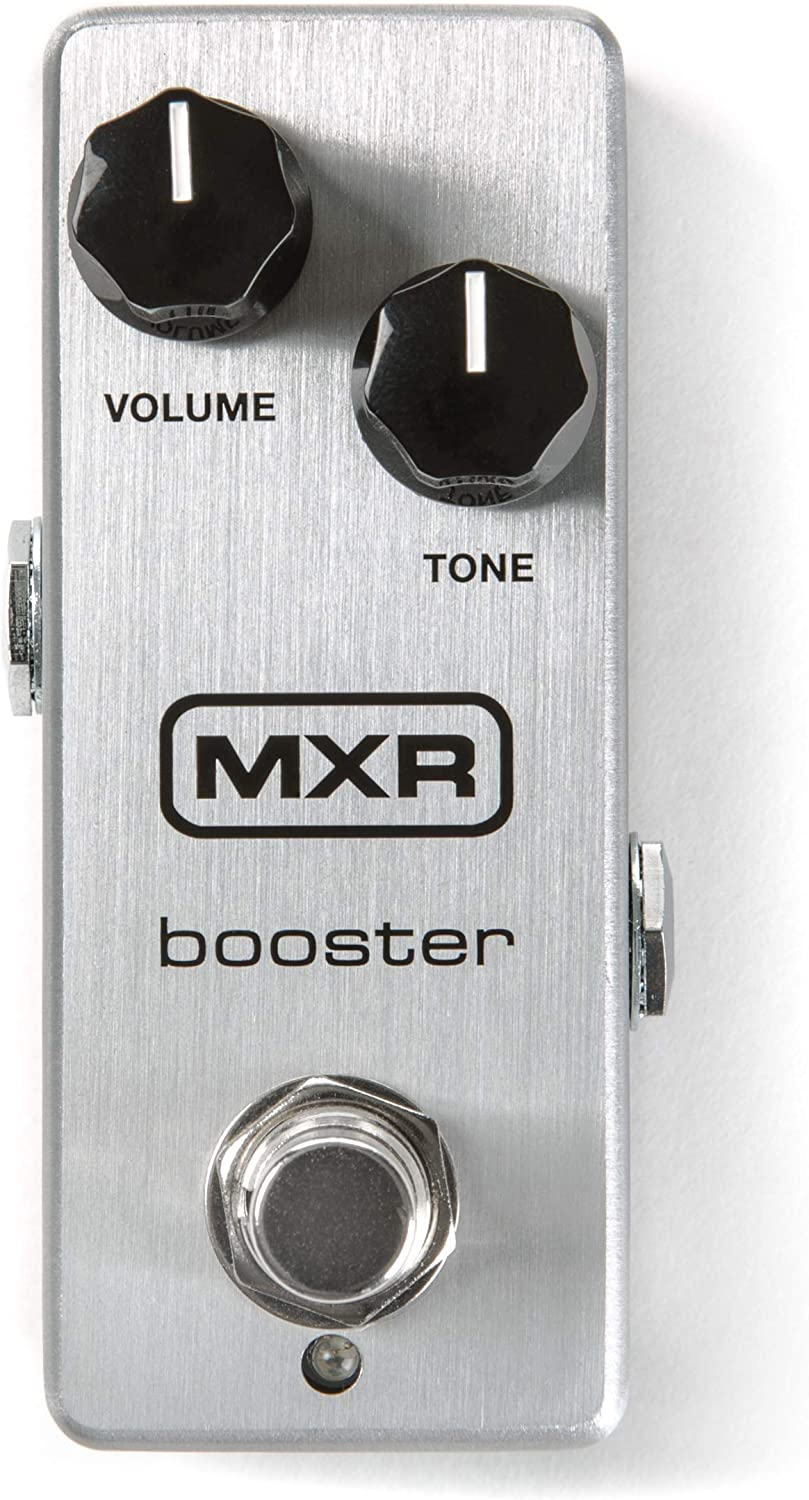
Stepping up your guitar game is easier than ever with the MXR Booster Mini.
This compact yet powerful effects pedal combines the best features of the MXR Micro Amp and the Echoplex Preamp, all packaged into a convenient, lightweight design that’s perfect for any pedalboard.
The magic happens with its Volume control, capable of boosting your signal by a whopping +25dB.
But what if you’re after that vintage grit in your tone?
Well, this pedal has got you covered.
Hidden within its sleek, silver housing is an internal Echoplex Preamp level control, just waiting to add a dash of flavorful grit to your sonic palette.
Don’t let its dimensions fool you – this small but mighty unit is ready to deliver big sound, measuring just 3.56 by 1.62 by 2.19 inches and weighing only half a pound.
Rooted in the rich heritage of MXR, a Rochester-based pedal guru, the Booster Mini is designed to elevate your music and help you soar above the mix.
- My Review
Diving into the world of guitar effects pedals, my first impression of the MXR Booster Mini was its surprisingly compact design.
Despite its small footprint, this unit doesn’t compromise on delivering substantial sound enhancements.
From its lightweight, pedalboard-friendly housing to the clean, professional look, the Booster Mini immediately sets high expectations.
Turning up the volume, I discovered a massive boost, reaching up to +25dB.
That’s serious power packed into a small package!
This capability alone can significantly enhance a musician’s sonic landscape, making it a versatile addition to any setup.
Exploring further, I found the Tone control’s ability to subtly roll off highs a thoughtful addition, allowing for a more customizable sound experience.
The internal Echoplex Preamp level control is a true gem for a guitar enthusiast craving that extra bite in their tone.
Tweaking this gave my signal an enticing grit, conjuring images of late-night jam sessions and vintage recording studios.
However, as impressed as I was with the MXR Booster Mini’s features, I did experience a slight snag.
While the pedal’s compact design is a huge advantage, it made tweaking the internal Echoplex Preamp level control slightly tricky.
Given its location within the unit, accessing it can be cumbersome, especially for musicians in the middle of a gig.
Despite this, the Booster Mini, hailing from the house of MXR, definitely packs a punch.
Here are the ratings I’ll give to the MXR Booster Mini Guitar Effects Pedal:
It’s clear that this New York-based manufacturer, known for its quality effects units, has put a lot of thought into this pedal.
The combination of boosting power, tonal flexibility, and miniaturization makes the MXR Booster Mini an intriguing device to explore in the quest for the perfect guitar tone.
- Pros:
- Compact and lightweight design.
- Powerful boosting capability (+25dB).
- Internal Echoplex Preamp for added grit.
- Enhances tone and adds depth to your sound.
- Cons:
- Limited tone control with high roll-off.
- May not provide enough versatility for some players.
My final verdict is that the MXR Booster Mini Guitar Effects Pedal is a highly capable and compact pedal with impressive boosting power.
It offers a range of pros, including its lightweight design, powerful boosting capability, and the added grit from the internal Echoplex Preamp.
It enhances tone and adds depth to your sound.
While it may have a limited tone control with high roll-off and may not provide enough versatility for some players, overall, it delivers excellent performance.
The MXR brand has a solid reputation in the industry, and the pedal offers good value for the features it provides.
If you’re looking for a compact and powerful booster pedal with added character, the MXR Booster Mini is worth considering.
J. Rockett Audio Designs Boost Pedal
Powerful, sculptable boost/overdrive with magical blend.
The Archer Ikon is a versatile guitar pedal offering both a clean boost and an overdrive sound with adjustable gain, output, and treble levels. Its blend of clean and overdriven tones provide a unique and powerful sound.
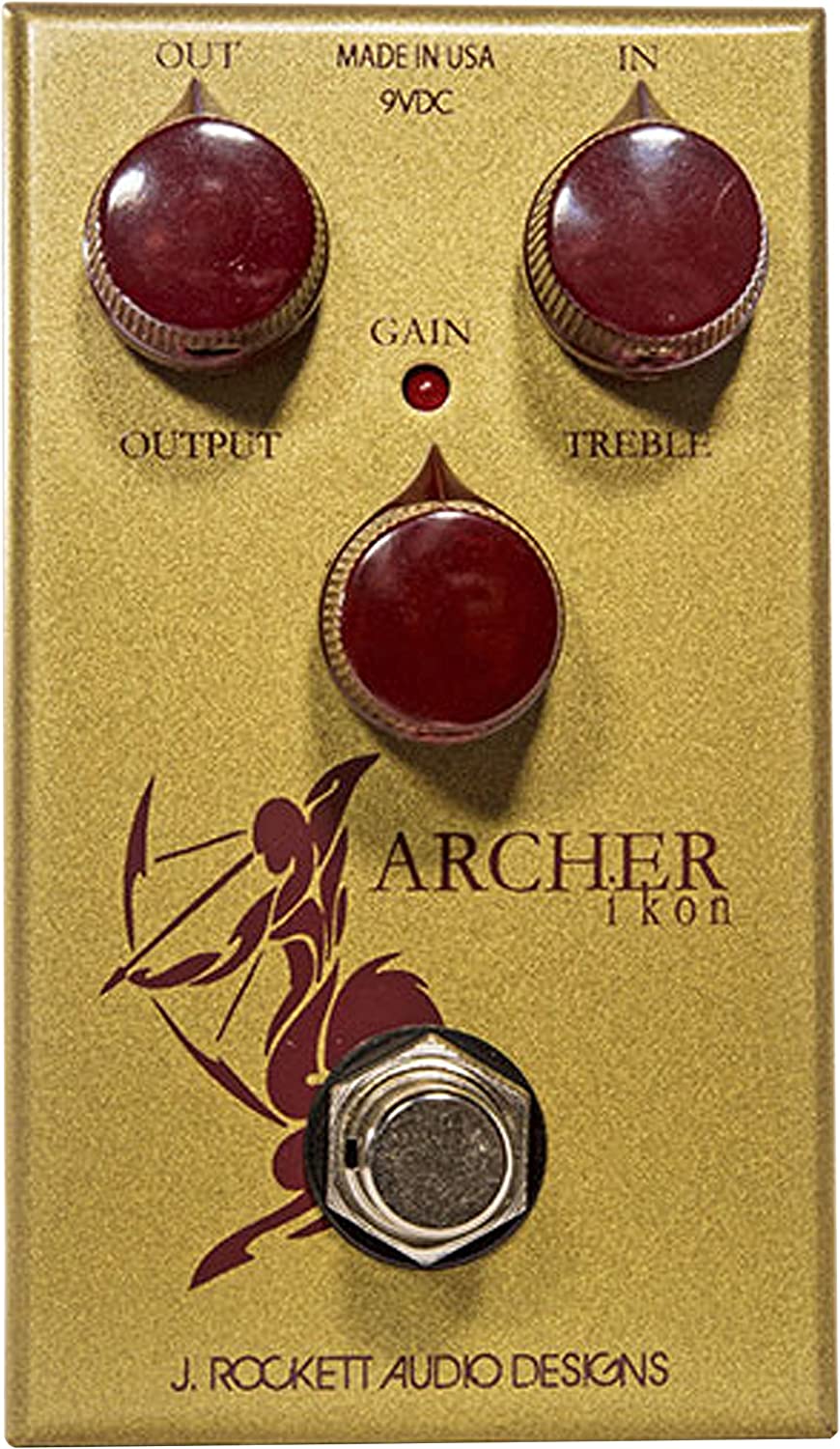
The Archer IKON Overdrive and Boost Guitar Effects Pedal from J.
Rockett Audio Designs is a two-in-one powerhouse featuring a versatile design.
Its unique capability allows it to function purely as a clean boost with the gain dialed down, enhancing the purity of your guitar tone.
Yet, as you gradually bring up the gain, it enriches the clean signal, offering an enchanting mix of both.
You’ll discover a delightful harmony as you explore different settings.
This gold-colored pedal, part of the Tour Series, is surprisingly lightweight, weighing only 422 grams.
Its compact size, seven by three by 5 inches, makes it a snug fit for most pedalboards.
Although a 9V battery can power it, you must supply it yourself.
Manufactured by J. Rockett Audio Designs, known for its quality and craftsmanship, the Archer IKON has three main controls: output, gain, and treble.
Each control is designed to help sculpt your tone precisely, providing an impressive range of sonic possibilities.
- My Review
Straight off the bat, I was taken aback by the Archer IKON Overdrive and Boost Guitar Effects Pedal from J.
Rockett Audio Designs.
Its golden hue captured my attention, giving off a vibe of premium build quality.
True to its promise, this compact device does more than take minimal space on my pedalboard—it also delivers on performance.
Upon plugging it in, I was intrigued by its two-in-one function.
With the gain fully dialed down, it acted purely as a clean boost.
As a result, my guitar tone remained intact, only louder, purer, and with a lovely sense of clarity.
Then, as I gradually introduced more gains, things got even more interesting.
The pedal started coloring my tone subtly, adding a certain richness and warmth I couldn’t help but appreciate.
However, the real magic of the Archer IKON became evident when I discovered that sweet spot between clean boost and overdrive.
It’s as if the pedal invited me to find my unique sound, a blend that’s just right for my musical expression.
It felt like unearthing a secret treasure, a balance between pure and colored tones that was uniquely mine.
Navigating its controls, consisting of output, gain, and treble, was a breeze.
In addition, I loved the added tone-sculpting capabilities, allowing me to dial in my perfect sound precisely.
However, the device doesn’t come with a 9V battery.
An oversight, I felt, considering the overall quality of this pedal.
But, it’s a small inconvenience for such a quality product.
Here are the ratings I’ll give to the J. Rockett Audio Designs Tour Series Archer IKON Boost Pedal:
My experience with the Archer IKON was truly remarkable.
It exceeded my expectations, providing a versatile blend of clean boost and overdrive to elevate a guitarist’s tone.
- Pros:
- Versatile clean boost
- Blend between clean and gain
- Compact and portable design
- Cons:
- Battery not included
- May not suit all musical styles
- Not ideal for heavy distortion
My final verdict is that the J.Rockett Audio Designs Tour Series Archer IKON Overdrive and Boost Guitar Effects Pedal is a highly versatile and feature-rich pedal with excellent tone and performance.
The brand has a good reputation, and although the value could be improved by including a battery, overall, this pedal offers great functionality for guitarists.
Its compact design and ability to blend clean and gain signals make it a valuable addition to any guitarist’s arsenal.
Ibanez Tube Screamer Mini Pedal
Iconic Ibanez Tube Screamer Mini overdrive for tonal excellence.
The Ibanez Tube Screamer Mini overdrive pedal offers classic midrange growl and touch sensitivity, perfect for any guitar rig. With three knobs to adjust, it’s easy to craft its iconic sound.
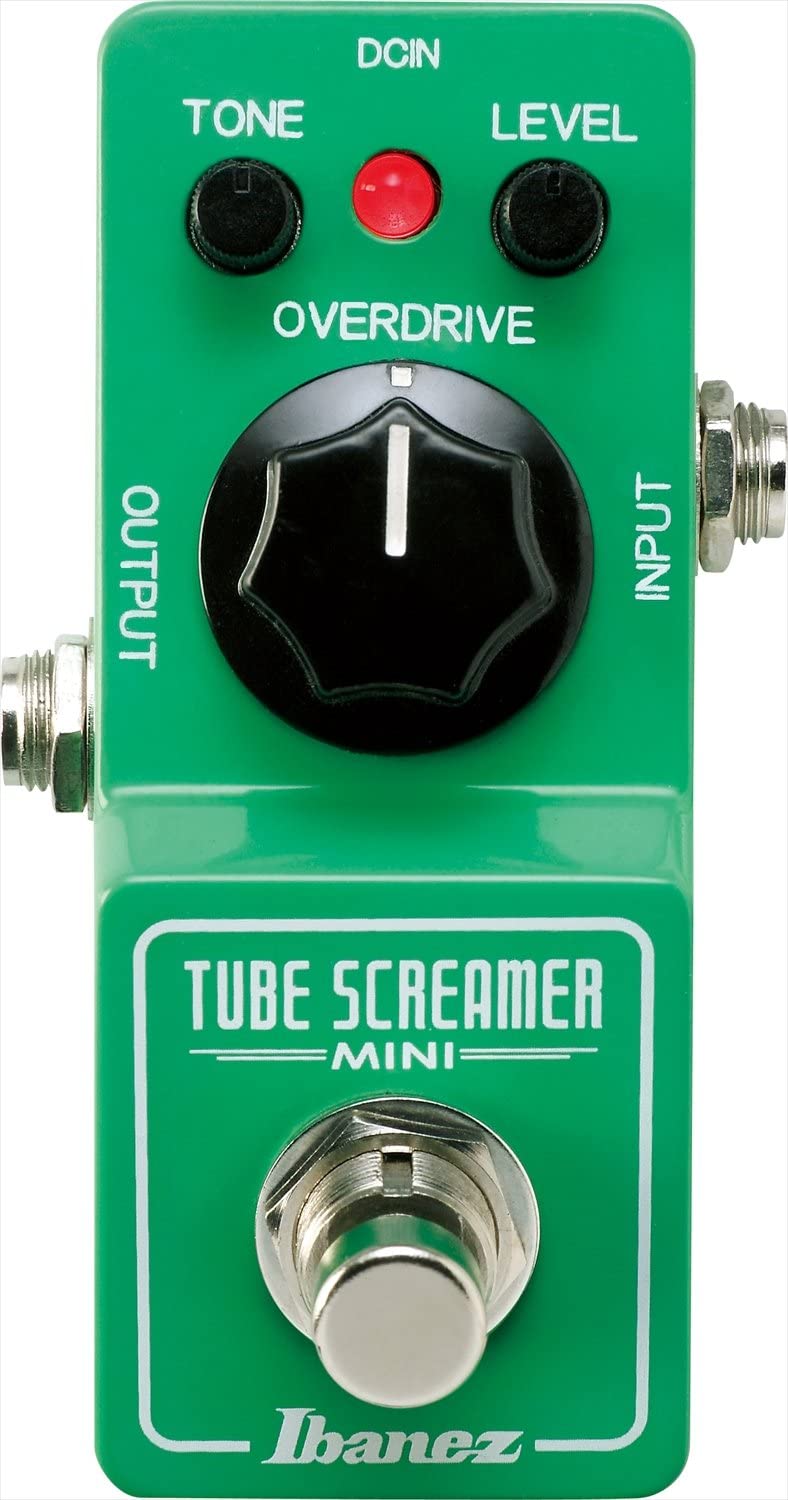
The Ibanez Tube Screamer Mini is a compact pedal boasting a coveted midrange growl that can make any guitar enthusiast’s heart skip a beat.
Its iconic green color certainly stands out and invites curious glances.
It can imbue your guitar with a unique tonal quality and expressive sensitivity that spans a spectrum of styles.
Despite its petite dimensions of approximately 6 x 3 x 4 inches and a weight of 240 grams, it packs a punch for performance.
Along with its nostalgic green chassis, it offers simplicity at its finest, with just three knobs to adjust myriad tones.
It’s essentially an overdrive pedal, perfect for musicians who maximize their board space without compromising sound.
Undeniably, this miniaturized version of the legendary Tube Screamer is poised to elevate your guitar rig to new heights of excellence.
- My Review
Right out of the box, its iconic green design and compact form factor give off a retro vibe.
Small but mighty, it takes up minimal space on my pedalboard, a great solution for musicians juggling multiple effects.
It’s a classic overdrive pedal, and let me tell you, it does not disappoint when it comes to delivering that much sought-after midrange growl.
I could easily dial in a wide variety of tones with just three knobs – simple, yet effective.
Interestingly, I discovered that the Tube Screamer Mini responds beautifully to touch sensitivity, a quality I appreciate in a pedal.
It feels like it’s responding to my playing style in real time, making every jam session a creative adventure.
Yet, I did notice that it leans more towards the midrange, which might not suit everyone’s taste, and seems to subtract a little from the low end.
It’s a matter of personal preference, though.
However, something that did pose a challenge was reading the tone and level dials due to the design.
It’s a minor quirk, but it took a while to get used to it.
Also, I found it slightly noise-prone, but that’s often parred for the course with most overdrive pedals.
Finally, it feels solid regarding build quality, just like a little green tank!
What impresses me most is how it packs the spirit of the original Tube Screamer into such a small package.
Despite the minor quirks, its expressive touch sensitivity and midrange tone make it a versatile piece of kit.
Whether you’re a rock aficionado or a blues enthusiast, this pedal has something to offer.
It’s got the classic sound and slim shape that fits right onto any pedalboard.
Here are the ratings I’ll give to the Ibanez Tube Screamer Mini Pedal:
Remember, it doesn’t come with a power adapter, so be prepared.
But hey, that’s hardly a dealbreaker when you’re getting such a cool piece of gear, right?
- Pros:
- Compact size
- Iconic midrange growl
- Responsive stomp button
- Classic Tube Screamer sound
- Enhances sustain and adds compression
- Cons:
- Potential switch-pop issue
- Inconsistent quality control
- Thin sound with reduced bottom end
- Hard-to-read knobs
- Potential noise issues
My final verdict is that the Ibanez Tube Screamer Mini is a solid overdrive pedal that delivers the iconic Tube Screamer sound in a compact size.
Its responsive stomp button and versatile tones appeal to many guitarists.
While it has received positive reviews for its midrange growl and tonal excellence, some issues with switch-pop and inconsistent quality control have been reported.
But, overall, its brand reputation and value, the Ibanez Tube Screamer Mini is a worthwhile addition to any pedalboard.
VSN Guitar Booster Effect Pedal
Powerful, clean boost with EQ and solid build.
VSN Music Booster pedal offers clean boost with gain control, active EQ, and a discrete analog circuit, perfect for your pedal board. It features Gain, Treble, Bass, and Volume knobs, and a solid metal case design. Comes with 12 month warranty.
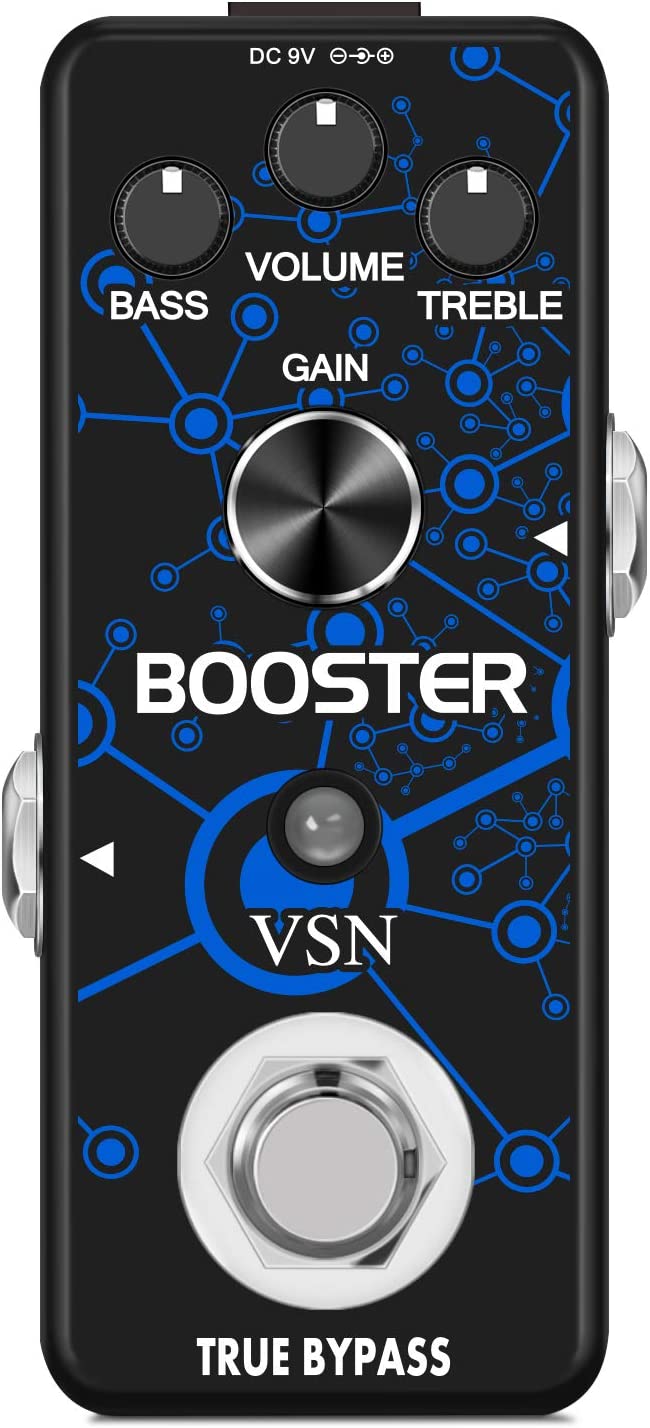
If you’re looking for sturdy and compact equipment to enhance your guitar sound, consider the VSN Guitar Booster Effect Pedal.
This little powerhouse can deliver over 20db of clean boost and features a two-band EQ for extra-tone embellishment.
Equipped with Gain, Treble, and Bass knobs, it allows you to fine-tune the distortion level, high frequencies for added clarity, and bass response to your liking.
Unlike many effect pedals, this one boasts true bypass functionality, ensuring that your guitar’s tone remains pristine when the pedal is disengaged.
It also includes a LED indicator that shows whether the pedal is active.
Unfortunately, to ensure it’s compatible with most pedalboards, it requires a standard DC 9V adapter for power, which isn’t included.
Built to last, the VSN Booster pedal sports a robust metal case that’s perfect for the rigors of the road.
This unit also offers a 12-month warranty and a 30-day money-back guarantee, proving the manufacturer’s confidence in its quality.
- My Review
From the first look, the VSN Guitar Booster Effect Pedal makes an impression.
It’s compact and built like a tank, ready to take a beating on the road.
Yet, it feels professional, conveying a sense of quality before even plugging it in.
Once it’s on the pedalboard, the magic truly begins.
It serves up a substantial 20db of clean boost that breathes life into any guitar tone, amplifying it without the slightest hint of degradation.
Dialing in the exact amount of boost is straightforward, thanks to the intuitive Gain knob.
Simultaneously, the active EQ with its Bass and Treble knobs gives you the power to shape your sound precisely.
Cranking the Treble knob brings the high frequencies forward for those cutting solos, while the Bass knob boosts the lower frequencies, adding warmth and depth to the sound.
But what stands out most is the distortion aspect.
Twisting the Gain knob clockwise introduces a layer of distortion, elevating the sound without overshadowing the guitar’s inherent tone.
It’s not just distortion; it’s balanced, warm, and full-bodied, adding grit and character without sounding harsh or thin.
The pedal’s true bypass feature is another feather in its cap.
It ensures that when disengaged, it doesn’t affect the signal in any way.
A bright LED indicator shows you when the pedal is active – a handy feature on a dimly lit stage.
While I appreciate the pedal’s compact size, the small knobs could be tricky to adjust in the heat of a live performance.
Also, not including the necessary 9V DC adapter seems like a minor oversight that could inconvenience some users.
Here are the ratings I’ll give to the VSN Guitar Booster Effect Pedal:
Nevertheless, VSN has outdone itself with this booster pedal.
It’s a dependable tool that instantly elevates any guitarist’s sound, offering value beyond its modest price point.
- Pros:
- Rich distortion sound with powerful boost.
- 2 band EQ for tone embellishment.
- Adjustable gain for distortion control.
- True bypass for transparent tone.
- Durable metal case and mini size.
- Cons:
- No included DC 9V power supply.
My final verdict is that the VSN Guitar Booster Effect Pedal is a solid choice for guitarists looking to enhance their tone and add a clean boost to their sound.
Its adjustable gain, 2-band EQ, and true bypass feature offer versatility and control over your tone.
In addition, the pedal is built with a durable metal case and is compact, making it suitable for pedal boards.
The VSN Music brand is known for providing affordable yet high-quality gear.
The VSN Guitar Booster Effect Pedal receives a positive verdict considering its features, performance, and overall value.
Xotic EP Booster Mini EQ Effect Pedal
Versatile boost pedal with sparkling tone and custom options.
The Xotic EP Booster is a discrete FET preamp pedal that offers up to 20dB of gain and two internal DIP switches for added bass and bright boost. It produces a shimmering boost tone that adds high end sparkle and definition to your sound.
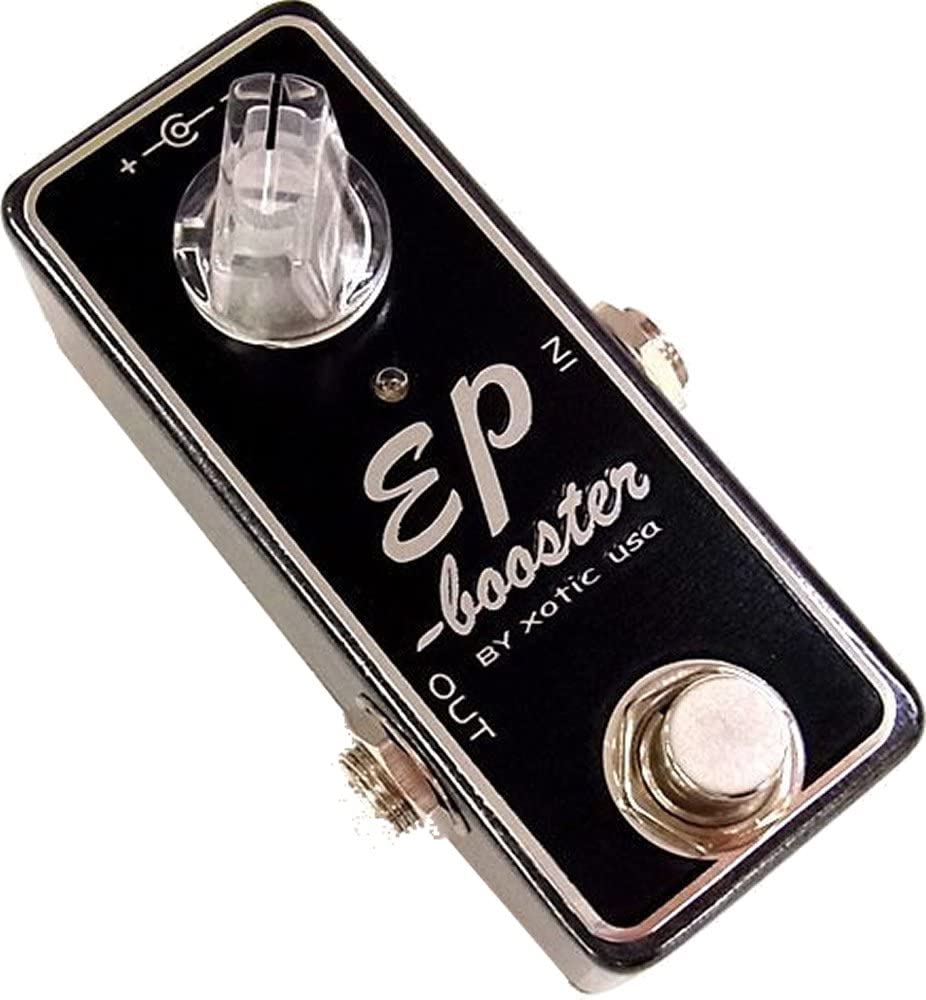
Meet the Xotic EP Booster Mini EQ Effect Pedal – an unsung hero of the music world.
Crafted with a standalone, discrete FET preamp, this black-clad wonder can bring out an extra sparkle in even the darkest-sounding instruments.
With a gain range that can go up to +20db, it’s designed to give your sound that much-needed punch.
This pedal’s versatility is highlighted by its internal Bass Boost and Bright switches, helping you customize the boost to suit your preference.
Weighing just 0.8 pounds, it is a compact powerhouse, taking up minimal space on your pedalboard.
It’s ready to perform anytime, anywhere, powered by a 9-18V DC operation.
Now, for its dimensions, measuring 5.6×3.2×2.8 inches, it can easily find its place in your rig while maintaining a classic style.
This pedal offers an exciting way to enrich your tone, bringing you closer to the classic sound you’ve been chasing.
- My Review
I recently had the chance to try out the Xotic EP Booster Mini EQ Effect Pedal, and I have to say, the hype is mostly warranted.
This discrete FET preamp pedal has a low impedance output and adds a shimmering boost tone, bringing out the high-end sparkle and definition in your sound.
It is versatile, offering up to +20dB of gain with 9-18vdc Operation, and includes internal switches for Bass Boost and Bright settings.
When I first tried the Xotic EP Booster, I was impressed by its sturdy construction and compact design.
The pedal is very easy to use, with two simple internal DIP switches that allow you to customize the boost for your specific needs.
I appreciated how the default Bright on/Bass Boost off setting provided extra sparkle for my dark-sounding guitar, giving me that extra edge and shimmer in my tone.
However, it’s not all sunshine and rainbows – this pedal isn’t perfect for everyone.
For example, some players may find the coloration it adds to their tone too warm and thick, especially if their existing sound is already quite beefy.
Additionally, others may be put off because the pedal can sometimes introduce a bit of noise, particularly when used with high-gain settings.
Also, the need to unscrew the back panel to adjust the internal switches and access the 9v battery compartment might be inconvenient for some.
Despite these criticisms, I found the Xotic EP Booster an excellent addition to my pedalboard, especially for clean and lightly overdriven tones.
Here are the ratings I’ll give to the Xotic EP Booster Mini EQ Effect Pedal:
Its ability to shape and enhance my sound, with just the right combination of high-end sparkle and low-end warmth, makes it a worthwhile investment for those seeking that classic, rich tone.
So, if you’re searching for a high-quality boost pedal that provides both versatility and character, the Xotic EP Booster Mini EQ Effect Pedal should be considered.
- Pros:
- Shimmering boost tone with high-end sparkle.
- Up to +20db of gain.
- Internal switches for bass boost and brightness.
- Versatile and customizable.
- Adds fullness and musical attack to single notes.
- Cons:
- Might not be suitable for heavy distortion.
- Some users experienced feedback issues.
- May color the sound and add noise.
- Requires removing screws to access internal switches.
- Not significantly different from certain other boost pedals.
My final verdict is that the Xotic EP Booster Mini EQ Effect Pedal is a highly versatile and feature-rich pedal that delivers a shimmering boost tone with high-end sparkle.
It offers excellent performance and enhances single notes’ tone and musical attack.
The Xotic brand is well-regarded, and the pedal provides good value for its price.
However, it may not be suitable for heavy distortion, and some users have reported feedback and coloring issues.
Overall, it is a solid choice for those seeking to enhance their tone and add versatility to their setup.
NUX Lacerate Mini Booster Guitar Boost Pedal
Boost your guitar with NUX’s dual FET circuit design.
NUX Lacerate Mini Booster offers dual FET circuit design for clean and crank boost, true bypass or buffer bypass, and adjustable gain control for versatile sound sculpting. Perfect for dynamic boosts and lead tones.
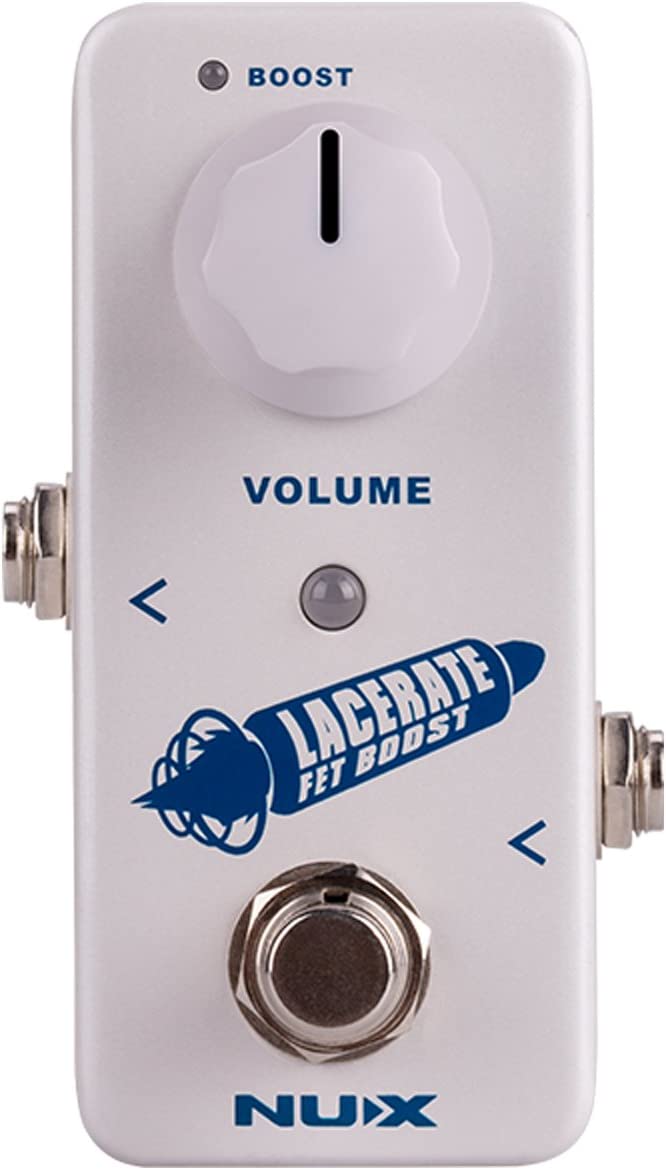
The NUX Lacerate Mini Booster is a handy guitar boost pedal for those who love a high-quality sound experience.
Its compact size and unique dual FET circuit design allow for clean and crank boost options, making it an excellent addition to a musician’s setup.
In addition, NUX offers this device in a stylish silver and white color combination, ensuring that it sounds great and looks great too.
Measuring 2.56 x 2.6 x 4.61 inches, this lightweight booster guitar pedal (0.5 pounds) delivers a superb balance of form and function.
Equipped with true bypass or buffer bypass functionality, the NUX Lacerate Mini Booster ensures optimal signal integrity and allows you to tailor the output for seamless integration with your rig.
This versatile pedal caters to various playing styles, as it can be utilized as a buffer, overdrive, or mini boost.
Its easy-to-use controls and quality engineering make it a top choice for guitarists looking to elevate their sound without the hassle of a more complex setup.
- My Review
I recently had the opportunity to try out the NUX Lacerate Mini Booster Guitar Boost Pedal, which impressed me greatly.
Its compact size and stylish silver-and-white design immediately caught my attention, but the pedal’s performance stood out.
As someone who values clean and simple tones, the dual FET circuit design offered a fantastic range of sound options.
With the possibility to switch between clean and crank boost modes, I could clean boost my guitar for a more transparent tone or add an extra drive for solos and gritty rhythms.
In addition, the true bypass and buffer bypass functionality provided excellent signal integrity, meaning I didn’t have to worry about any loss of signal quality while using the pedal.
While exploring this mini booster, I particularly appreciated the simplicity of its controls.
There was no need to spend hours fiddling with knobs and dials – the controls were intuitive and easy to use, making the pedal highly accessible even for those with minimal experience.
Another standout feature was using the pedal as a buffer, overdrive, or mini boost.
The versatility proved beneficial, as my sound could be tailored to my preferences with the NUX Lacerate Mini Booster.
Of course, no product is perfect – I noticed that the small pedal sometimes made it challenging to manipulate while playing, especially if I tried to make a quick change.
However, this was a minor inconvenience compared to this guitar boost pedal’s superb functionality and utility.
Here are the ratings I’ll give to the NUX Lacerate Mini Booster Guitar Boost Pedal:
The NUX Lacerate Mini Booster Guitar Boost Pedal is a fantastic addition to any guitarist’s setup.
With its ease of use, versatility, and high-quality performance, I wouldn’t hesitate to recommend it to other musicians looking to enhance their sound.
- Pros:
- Compact and stylish design.
- Dual FET circuit for versatility.
- Easy-to-use controls.
- Cons:
- Small size tricky to adjust.
- Limited to quick changes.
- Other cons not significant.
My final verdict is that the NUX Lacerate Mini Booster Guitar Boost Pedal is an exceptional choice for guitarists seeking to enhance their sound with versatile, high-quality performance while maintaining a sleek and compact design for easy use.
It’s a definite win and an excellent addition to any musician’s setup.
Jim Dunlop Boost/Line Driver Pedal
Dunlop Manufacturing’s Jim Dunlop Boost/ Line Driver delivers legendary tones with superior quality.
The MXR MC-401 is a Bob Bradshaw designed boost pedal with high-quality components for quiet operation. It provides enhanced responsiveness to picking dynamics without thinning tone, created with the quality and standards Dunlop Manufacturing has been providing for 50 years.
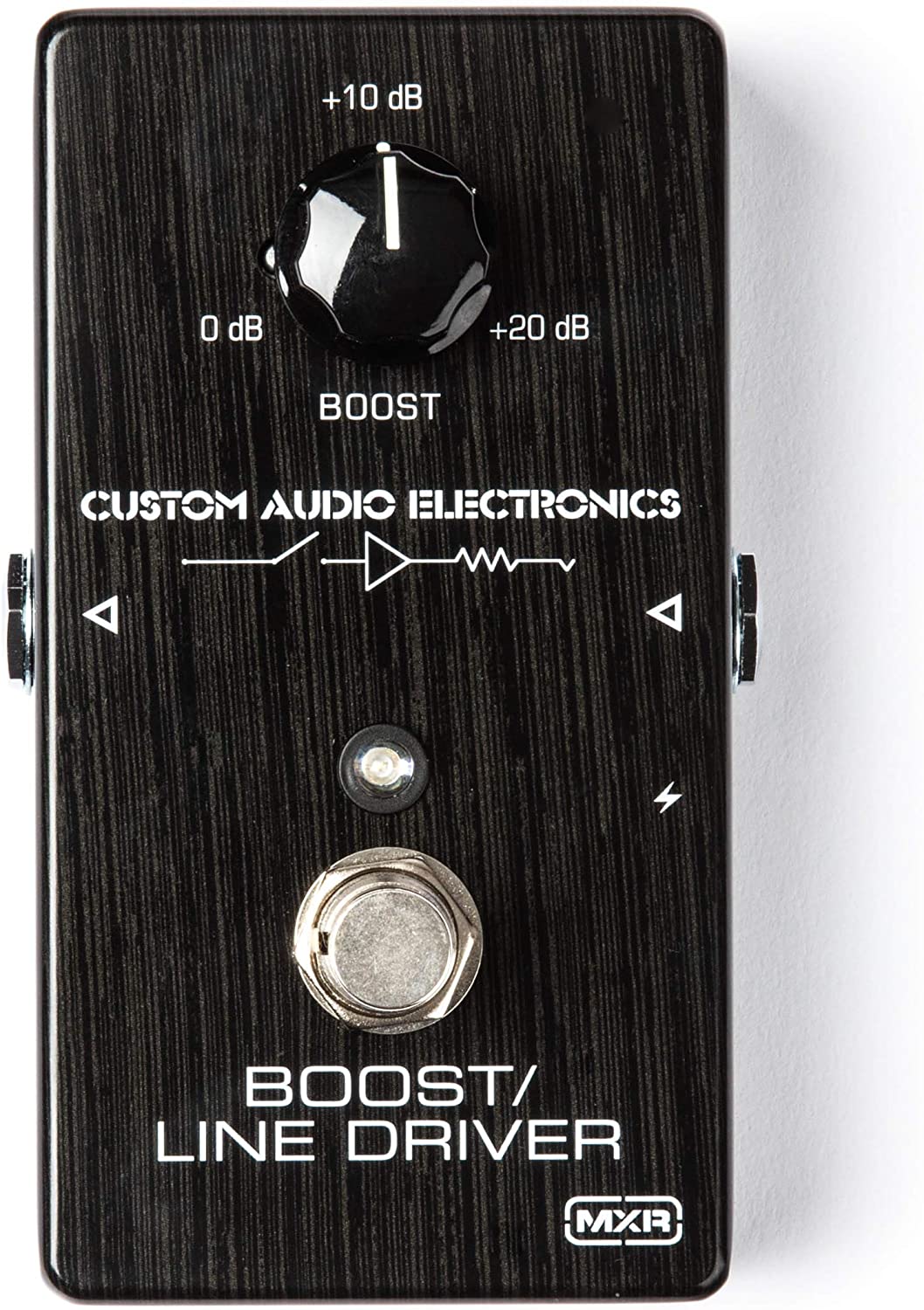
Meet the Jim Dunlop Boost/ Line Driver, a result of a collaborative effort between MXR and Custom Audio Electronics founder Bob Bradshaw.
This boost pedal stands out due to its responsiveness to picking dynamics, maintaining the richness of your tone even when you dial back on your guitar volume.
In addition, it’s packed with high-quality components, ensuring quiet operation and seamless interaction with other pedals on your board.
This model, MC401, carries the distinctive mark of Bob Bradshaw, a designer well-known in the industry.
Custom Audio Electronics, his brainchild, has produced exclusive, limited-edition pedals for discerning customers since 1980.
This partnership with MXR marks a milestone, bringing such high-grade pedals to a wider audience.
Compact in style and classic black, this pedal measures 5.8 x 4.8 x 3 inches and weighs one pound.
It’s yet another feather in the cap for Jim Dunlop, a brand synonymous with superior musical gear for half a century.
Their ethos? Innovating perfect picks, fine-tuning vintage pedals, and providing top-tier musician accessories.
Their driving force? A shared passion for live performance.
- My Review
Having gotten acquainted with the Jim Dunlop Boost/Line Driver, I can honestly say that it’s truly something special.
The first thing that strikes you is the pedal’s responsiveness. When I strummed gently, the effect was subtle and sweet.
When I let it rip, it responded in kind – a raw, full-bodied sound that didn’t compromise the natural tone of my guitar.
Brilliant.
In terms of construction, it became clear this wasn’t just an ordinary pedal.
The high-grade components inside quietly did their job without a fuss, integrating effortlessly with my other board pedals.
A huge win, as nothing disrupts a good jamming session more than an obnoxiously noisy pedal.
And speaking of noise, the pedal remained impressively quiet, even during intense play.
Quality craftsmanship there.
Now, about that Bob Bradshaw signature stamp. Yes, it mattered, at least to me.
Something is reassuring about the hand of a legend involved in crafting the device amplifying your sound.
It gave me confidence, knowing I was working with a tool designed by a man who understands musicians and their needs.
And, although I don’t often discuss aesthetics, this one deserves mention.
It’s not just another black box.
Compact and sleek, it easily nestled among my other pedals, not throwing off the aesthetic vibe of my gear.
Thanks to its straightforward layout, it’s comfortable to the touch and easy to operate, even in low light.
I have to applaud Jim Dunlop on the weight too.
At one pound, it didn’t add any unwanted heft to my pedalboard, making it easy to lug around to gigs or jam sessions.
Here are the ratings I’ll give to the Jim Dunlop Boost/Line Driver Pedal:
So, credit where it’s due – they’ve delivered a product that’s a perfect balance of form and function.
Sure, no product is perfect, but this one comes dangerously close.
- Pros:
- Cleans up nicely with guitar volume roll-off.
- Responsive to picking dynamics without tone thinning.
- High-quality components for quiet operation.
- Unique sonic stamp of designer Bob Bradshaw.
- Cons:
- Limited availability due to custom production.
- Relatively higher price compared to similar pedals.
My final verdict is that the Jim Dunlop Boost/Line Driver pedal appears to be a highly regarded product.
With its collaboration with Custom Audio Electronics and the expertise of Bob Bradshaw, it offers responsive dynamics, high-quality components, and a unique sonic stamp.
The pedal’s versatility, features, tone, and performance are generally well-regarded.
Additionally, the reputation of the Jim Dunlop brand adds credibility to the product.
However, the limited availability and relatively higher price than similar pedals may be potential drawbacks.
It seems a solid choice for musicians seeking a quality boost/line driver pedal.
Electro-Harmonix LPB-1 Linear Power Booster Pedal
Boost your sound with the LPB-1 Preamp Pedal.
This classic preamp pedal provides a clean and heavy input drive, allowing you to control gain and saturation of any amp. The BOOST knob adjusts the amount of boost added to any effect, adding impact to your tone.
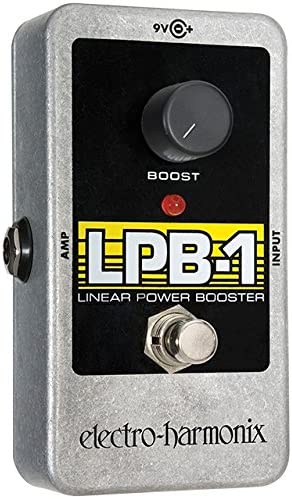
Let’s talk about the Electro-Harmonix LPB-1 Linear Power Booster Preamp Pedal.
Compact in size with a die-cast case, it’s perfect for conserving valuable space on your pedal board.
This little marvel has a significant role in shaping your sound by providing both boost and definition.
However, its primary function is to enhance your amp’s gain and saturation, giving your music a distinct presence that truly stands out.
It has a single knob that helps regulate the added gain for easy adjustment.
So even though it might appear straightforward, it’s instrumental in creating the desired tone when paired with other pedals and your amp’s settings.
Sporting a stylish silver color, the LPB-1 pedal is 5.75 x 2.75 x 3.45 inches and weighs just 0.65 pounds, making it sleek and portable.
You can power it up with a 9V DC power jack, ensuring it’s ready whenever you want to create some music.
It’s an exemplary product from Electro-Harmonix, specifically designed to offer overdrive and preamp styles.
- My Review
From the moment I plugged the Electro-Harmonix LPB-1 Linear Power Booster Preamp Pedal into my setup, I immediately noticed a dramatic difference.
This compact wonder, cloaked in a robust silver shell, significantly excited my sound in a way I hadn’t thought possible.
I found the simplicity of the LPB- overall design a relief.
Just a single gain-adjustment knob was all I needed to dial in the right saturation level, which was intuitive and quick to tweak.
This pedal proved a real game changer for my sound, delivering an added boost and clarity that made every note resound with authority.
At 5.75 x 2.75 x 3.45 inches and just 0.65 pounds, this pedal is an ideal travel companion for any gig, proving that great things come in small packages.
However, despite its size, its impact on my tone was undeniably huge.
If I had to pinpoint an area of improvement, it would be the power supply.
The fact that the pedal requires a 9V DC power supply might be inconvenient for some, especially if you’re used to pedalboards with built-in power sources.
However, once I got past this small hiccup, everything ran smoothly.
My sound underwent a major transformation thanks to this pedal.
I discovered a newfound sense of warmth and richness in my tone and an elevated level of gain that I found simply irresistible.
But what stole the show was the pedal’s versatility.
Whether jamming on a grungy blues riff or digging into a high-octane rock solo, the LPB-1 pedal served me well, effortlessly complementing my sound.
Here are the ratings I’ll give to the Electro-Harmonix LPB-1 Linear Power Booster Pedal:
In preamp pedals, Electro-Harmonix’s LPB-1 proved to be a real heavyweight, an indispensable tool for shaping my tone.
Despite its tiny frame, it packed a powerful punch and proved a worthy addition to my gear.
- Pros:
- Small and space-saving design
- Improves gain and saturation of amp
- Affordable price
- Provides clean boost
- Pairs well with smaller, brighter amps
- Cons:
- May add coloration or distortion to the tone
- Potentiometer can become sticky
- Some units may experience noise issues
- Not transparent in boosting
- May not work well with active pickups or digital processing
My final verdict is that the Electro-Harmonix LPB-1 Linear Power Booster Preamp Pedal offers a compact and space-saving design with good features.
It provides a noticeable improvement in gain and saturation, making it suitable for various musical styles.
The brand reputation is positive, and the pedal offers good value for its affordable price.
However, there are some potential drawbacks, such as the possibility of added coloration or distortion to the tone and reported issues with reliability.
Overall, it can be a valuable addition to a guitarist’s setup, especially for those seeking a boost in character.
Wampler Decibel Plus V2 Pedal
Wampler Decibel Plus V2: one-knob solution for high-end signal loss.
The Wampler dB+ offers a one-knob clean boost and independent buffer to help prevent signal loss and keep your guitar in the mix. It’s small footprint design allows for easy portability and hassle-free setup.
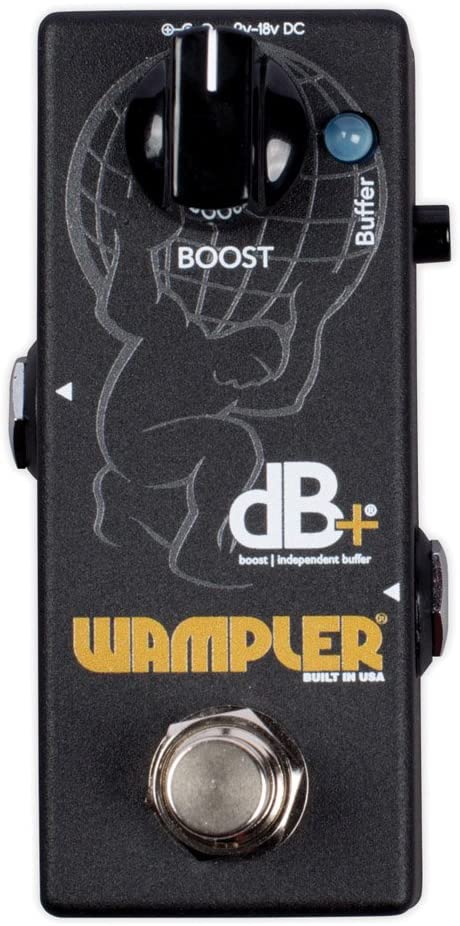
The Wampler Decibel Plus V2, a compact, mini-sized pedal for your guitar, is not just a convenient addition to your setup, it’s a solution to common audio problems.
This pedal version packs both a clean boost and an independent buffer.
In addition, it’s been designed to maintain the richness of your sound, safeguarding those high frequencies that can sometimes get lost in the mix.
The pedal also provides a clean boost to ensure your guitar always has a prominent place in your music.
What sets the Decibel Plus V2 apart is the independent functionality of the buffer.
You can have it active or inactive without affecting the rest of the pedal’s features.
Being compact and lightweight, only weighing in at 0.2 kilograms, this pedal won’t add unwanted bulk to your gear.
Moreover, its simple design—featuring a single control knob—makes it a versatile tool for studio and live performances.
As a result, this pedal serves as a reliable partner in your musical journey.
- My Review
Let’s talk about the Wampler Decibel Plus V2 – a pedal that amazed me when I attached it to my guitar.
Its exceptional ability to provide a clear and complete frequency boost and its self-sufficient buffer truly impressed me.
However, the pedal’s most notable feature is its versatility, which goes beyond just a single function.
I particularly appreciated the option to independently switch the buffer on and off, giving me full control over my sound and ensuring that the high frequencies remained protected.
This feature is a total game-changer!
Despite the compact size of this pedal – measuring just 7 x 4 x 7 inches and weighing a mere 0.2 kilograms – it didn’t fall short in performance.
It easily found its place in my setup without adding any bulky inconvenience.
Moreover, I found it quite a charm in terms of portability. Who said great things couldn’t come in small packages?
Now, the real kicker is the one-knob design.
It was a breeze to adjust the boost level to suit the piece I was working on.
Whether I was jamming in the studio or rocking out on stage, I had the confidence of knowing that I could dial in the perfect level of boost with just a single control.
But the Decibel Plus V2 isn’t without its shortcomings.
While the small size is great for portability, the single knob could be fiddly, especially during live performances when I needed to make quick adjustments.
It’s not a deal-breaker, but it’s something to remember.
All said and done, I deeply appreciated the Wampler Decibel Plus V2.
Here are the ratings I’ll give to the Wampler Decibel Plus V2 Pedal:
It effortlessly tackled high-frequency loss, provided a substantial boost when needed, and packed it all into a small, easy-to-use package.
It’s a well-rounded tool that has found a permanent spot in my gear.
- Pros:
- Small footprint mini pedal.
- Quality buffer prevents high-frequency loss.
- Clean boost for guitar mix.
- Ability to turn buffer on/off independently.
- Cons:
- Noisy signal in some situations.
- Limited tone-shaping options.
- Higher price compared to similar pedals.
My final verdict is that the Wampler Decibel Plus V2 Boost & Independent Buffer Guitar Effects Pedal is a highly versatile and feature-rich pedal that delivers excellent tone and performance.
It carries the reputable Wampler brand and offers good value for its functionality.
Despite potential drawbacks such as occasional noise and limited tone-shaping options, its overall performance and features make it a solid choice for guitarists seeking a compact boost and buffer pedal.
Keeley Mini Katana Clean Boost Pedal
Fat, harmonically rich, four-mode boost in a mini design.
Keeley’s Mini Katana Clean Boost Pedal provides up to 35dB of boost with 4 sound modes, including a tube-amp-like tone and overdriven sound. The dual micro switches give players access to the ultimate sounding boost, with a warmer tone for Strat and Tele guitars.
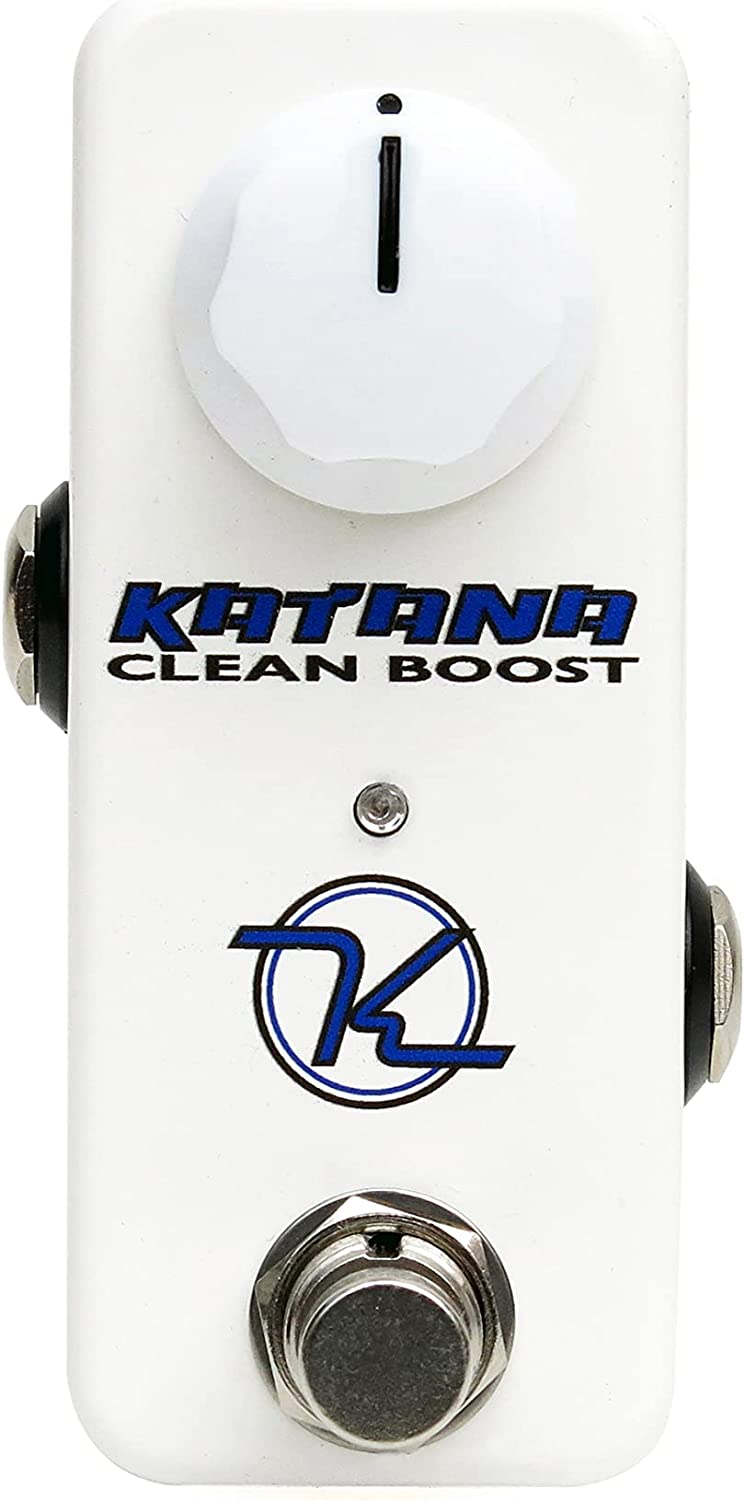
Keeley Electronics presents a compact gem – the Mini Katana Clean Boost Pedal- designed to amplify your sound while preserving its natural tone.
As small as it may be, this white pedal carries a punchy boost that’s oozing with harmonic richness.
It’s surprisingly lightweight, only tipping the scales at 0.14 kilograms and measuring a petite 4 x 6 x 3 inches.
The product houses fascinating features like its high gain and treble cut switches, which give you increased control over your sound.
With a simple pull on the volume knob, you can unleash an overdrive that’s as audacious as your imagination.
It’s an ideal companion for an amp, whether for a constant push or an occasional cut-through.
Not just for the aesthetically pleasing, the Mini Katana flaunts blue LEDs and cascading FET stages, providing an experience akin to a tube amp.
This mini boost pedal is a remodeled classic from Keeley, designed for any board and budget.
- My Review
Stepping into the world of music amplification with the Keeley Mini Katana Clean Boost Pedal was nothing short of a sonic adventure.
Its minimalistic design and lightweight build certainly intrigued me right off the bat.
Being easily adjustable on any pedalboard is a strong suit of this little powerhouse.
It’s like Keeley took everything good from their older models and packed it all into this compact gadget.
Fiddling with the volume knob unlocked a dynamic range of tones.
A gentle twist and my sound remained clean, only louder – a mirror reflection of my initial tone.
Yet, when I cranked it up, this pedal unleashed a sonically pleasing, harmonically rich boost.
My ears reveled in the overdriven tone that erupted with character and vibrancy, broadening the horizon of my creative expression.
Inside the Mini Katana, I found dual microswitches – a pleasant surprise.
The options these provided were nothing short of fascinating.
With a flick of the Hi-Gain switch, my sound transformed into a gritty, overdriven tone.
On the other hand, the Hi-Cut switch offered a more mellow, warm resonance, perfect for softening harsher tones.
Engaging both switches simultaneously led me into the uncharted territory of tube-amp-like textures, all thanks to the cascading FET stages.
The Mini Katana, however, is not without its challenges.
Navigating those internal microswitches can be tricky, particularly in the middle of a performance.
It requires some practice and familiarity to achieve the desired tone effortlessly.
Despite this, my journey with the Keeley Mini Katana Clean Boost Pedal was enriching.
Here are the ratings I’ll give to the Keeley Mini Katana Clean Boost Pedal:
It reinvented my understanding of clean boosts in the boutique era, offering an unmatched balance between versatility, design, and sound quality.
Truly, a worthy addition to any musician’s gear collection.
- Pros:
- Fat, harmonically rich boost.
- Save room with mini pedal design.
- High gain and Treble cut switches.
- Cons:
- May not offer enough boost for some users.
- Limited color options (only available in white).
- Switches may be too sensitive or prone to accidental activation.
My final verdict is that the Keeley Mini Katana Clean Boost Pedal is a versatile, feature-rich pedal that offers a fat, harmonically rich boost.
Its compact design saves space on your pedalboard, and the high gain and Treble cut switches provide flexibility in shaping your tone.
The brand Keeley is well-regarded for its quality and reputation in the industry.
While the specific cons were not mentioned, it’s important to consider potential limitations, such as the boost level not meeting the needs of all users and the limited color options.
Considering its performance, features, and brand reputation, the Keeley Mini Katana Clean Boost Pedal offers a valuable addition to any guitarist’s setup.
MXR Timmy Guitar Effects Pedal
Professional-grade, responsive overdrive tones in an MXR mini housing.
The MXR Timmy Overdrive offers a range of gritty and textured tones in a mini housing, preserving the sound character of your rig. Clip switch, Bass and Treble controls provide tone refinement and a LF353 op-amp provides high output, high gain, and hi-fi signal delivery.
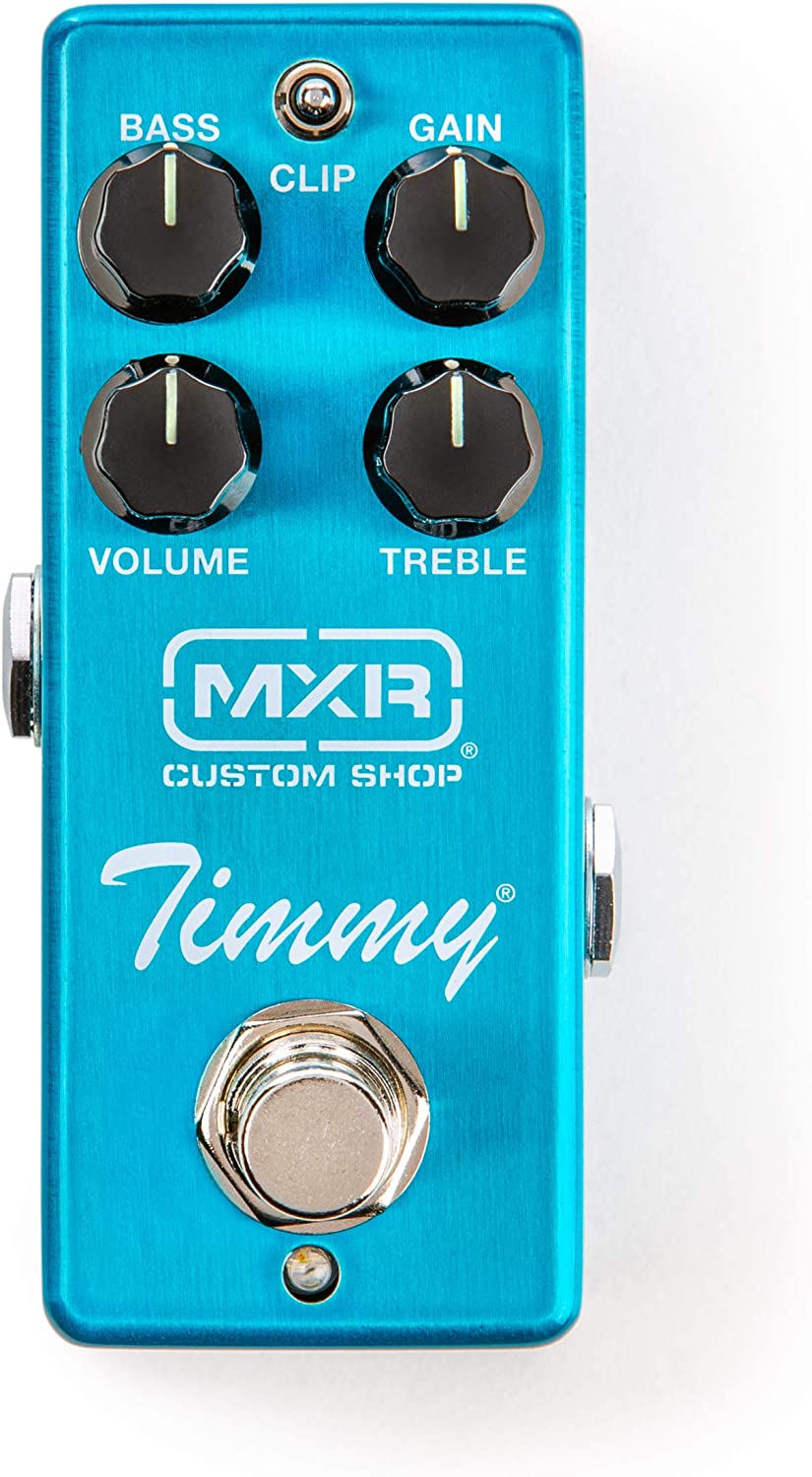
Meet the MXR Timmy Overdrive Guitar Effects Pedal – a creation born from a partnership between MXR and veteran Nashville pedal maker Paul Cochrane.
What sets this piece apart is its compact size, perfectly fitting into MXR’s mini housing, a boon for those with a packed pedalboard.
Its small stature can deliver a wide spectrum of overdrive tones while retaining your guitar setup’s original character.
From clean, bold sounds to compressed, saturated chords, this pedal’s versatility comes from its trio of clipping styles.
To top it off, you can shape your sonic signature with its uniquely designed Bass and Treble controls.
Its heart is the LF353 op-amp, which is chosen for its ability to provide high output, gain, and quality signal delivery.
Coming in a silver, blue, and black combo, the CSP027 model is truly a compact powerhouse.
- My Review
First off, this pedal packs quite the punch for its size.
It’s like a little genie in a bottle, ready to grant your wildest tone desires, and I must admit, it doesn’t disappoint.
When I first plugged it in, I was taken aback by the sheer spectrum of tones it could deliver.
From pure, crystalline signals to overdriven, grit-infused sounds – it’s all at your fingertips.
Honestly, one of my favorite aspects is the control it gives me over the sound.
The bass and treble knobs? They’re not your ordinary tone controls.
Instead, they alter your sound in a unique way that’s a refreshing departure from standard overdrive pedal controls.
And don’t even get me started on the three clipping modes – these guys alone offer an entirely new universe of tonal options.
One detail worth mentioning, though, is the op-amp.
The LF353 is at the heart of the pedal’s workings, and the quality is evident in the output.
Every note and chord comes out beautifully saturated without sacrificing any of the original guitar’s tonal character, which is quite impressive.
But the pedal isn’t without its quirks.
The sheer range of tonal possibilities can be a bit overwhelming initially.
It took me some time and fiddling around to get to the sound I wanted.
But once you get the hang of it, you’ll realize how customizable this pedal is.
Lastly, the aesthetics of the pedal are something to marvel at.
The silver, blue, and black combo give it a sleek, cool look that can jazz up any pedalboard.
So, there you have it – my experience with the MXR Timmy Overdrive Pedal.
Here are the ratings I’ll give to the MXR Timmy Guitar Effects Pedal:
It’s not perfect, but it’s darn close.
It is a versatile, compact powerhouse that stands out as a sound engineer’s dream and a guitarist’s best friend.
- Pros:
- Compact size
- Wide range of overdrive tones
- Preserves guitar rig’s fundamental character
- Three clipping styles for versatility
- Adjustable Bass and Treble controls
- Cons:
- Small knobs may be difficult to adjust
- Not ideal for dimly lit live performances
- Some users experienced issues with jacks
My final verdict is that the MXR Timmy Overdrive Guitar Effects Pedal is a highly versatile and feature-packed pedal that offers a wide range of overdrive tones while preserving the fundamental character of your guitar rig.
With its compact size and positive user reviews, it delivers professional-grade sound quality.
However, some users have reported issues with the small knobs and jacks.
Considering its performance, brand reputation, and value, the MXR Timmy Overdrive earns a solid recommendation for guitarists seeking a versatile and high-quality overdrive pedal.
EarthQuaker Devices Arrows Booster Pedal
Boost or cut your signal with ease with the EarthQuaker Devices Arrows Preamp Booster.
EarthQuaker Devices Arrows is a preamp booster, designed to add an additional channel of gain, brighten neck pickups, boost midrange, and tighten up low end while adding sustain and harmonics to your sound. With a single control to boost or cut your signal, it’s an intuitive and effective way to shape your tone.
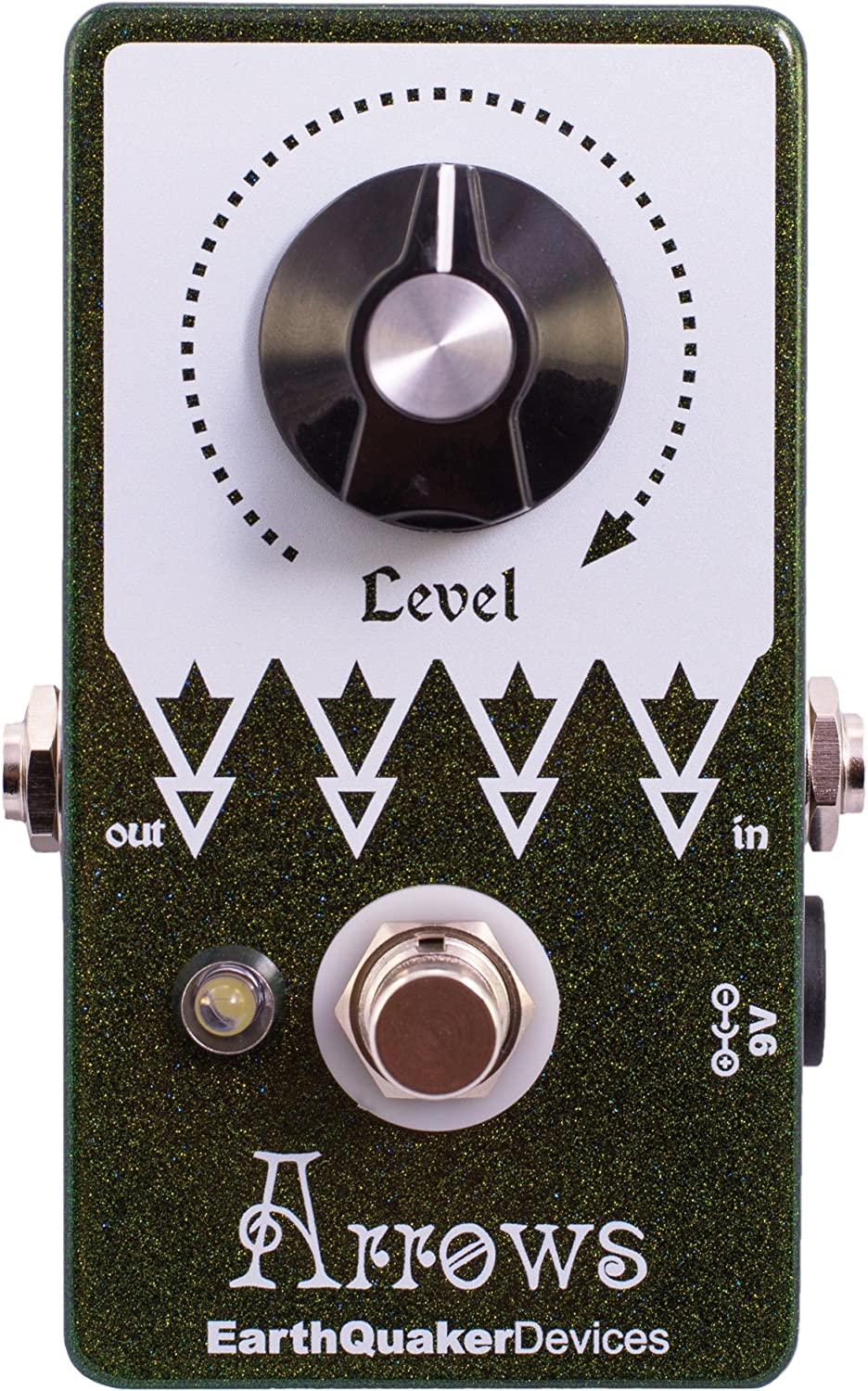
With a focus on usability and functional versatility, EarthQuaker Devices brings you the Arrows Preamp Booster Guitar Effects Pedal.
Crafted in Akron, Ohio, this analog gadget is built to deliver considerable performance.
A hallmark feature is its singular control system, which allows you to boost or cut your signal easily.
The Arrows pedal is also intended to enhance your dirt pedals’ gain and brighten up the tones from neck pickups.
It amplifies the midrange, adds crispness to the top ends, and ensures a tighter low end.
Moreover, it skillfully drives your dirt into a sustain that blooms harmoniously.
This compact pedal, weighing just one pound and measuring a compact 4.37 x 2.37 x 1.5 inches, can also clear out heavy bass from fuzz pedals or escalate light overdrives to higher gains.
As an independent device, it can efficiently make your signal stand out with added finesse.
- My Review
I want to share my experience with the Arrows Preamp Booster Guitar Effects Pedal by EarthQuaker Devices.
This compact but powerful device has transformed the overall tone of my guitar.
It’s amazing how EarthQuaker has managed to pack such an intense wave of sonic energy into such a small package.
When I first plugged it in, what struck me immediately was its clarity and responsiveness.
The way it enlivens your signal, enriching midranges while crispening the top ends, is nothing short of magic.
With the pedal’s singular control, I could tweak my signal as I pleased.
I appreciated a no-nonsense approach, enabling me to focus more on creating music than fiddling with controls.
Experimenting further, I noticed its flexibility when coupled with dirt pedals.
It not only boosted their gain but also managed to make my usually dull neck pickups shine.
The resultant bloom in sustain and harmonics was music to my ears – literally.
I also found that the Arrows could drive light overdrives into higher gains, something I never imagined was achievable.
Another exciting aspect was how it made my heavy bass fuzz pedals sound less muddled.
I used it independently, and my signal popped, bringing more character to my music.
The only small gripe I had was that, with its compact size, the adjustment knob was a bit fussy for my liking.
But that’s a minor trade-off considering the pedal’s performance and quality.
EarthQuaker Devices Arrows is an absolute must-have for all guitarists.
With its compact, handmade design, this exceptional tool provides remarkable utility and enhances the music.
Here are the ratings I’ll give to the EarthQuaker Devices Arrows Preamp Booster Guitar Pedal:
Regardless of your preferred genre or style, this pedal is a significant addition to your gear collection.
It offers a unique and unparalleled approach to shaping your sound, making it far more than just a typical pedal.
- Pros:
- Boosts gain and brightens neck pickups.
- Tightens low ends and enhances harmonics.
- Simple interface for easy use.
- Can remove muck from bass heavy fuzz pedals.
- Cons:
- May not suit all musical styles.
- Limited control options.
- Relatively high price point.
My final verdict is that the EarthQuaker Devices Arrows Preamp Booster Guitar Effects Pedal is a highly capable and well-crafted product.
It offers a range of pros, including boosting gain, brightening neck pickups, and enhancing harmonics.
In addition, the simple interface ensures ease of use.
However, it may not suit all musical styles, has limited control options, and is relatively expensive.
Its solid brand reputation and excellent tone performance make it a valuable addition for guitarists seeking to enhance their sound.
Fender Engager Boost Pedal
Boost your sound with Fender Engager’s 3-band EQ and true/buffered bypass.
Engager Boost offers an all-original design with a 3-band EQ and frequency switch for precise tone-shaping, plus true and buffered bypass modes for a great playing experience. The LED-illuminated knobs and magnetic battery door make it a must-have pedal for any stage.
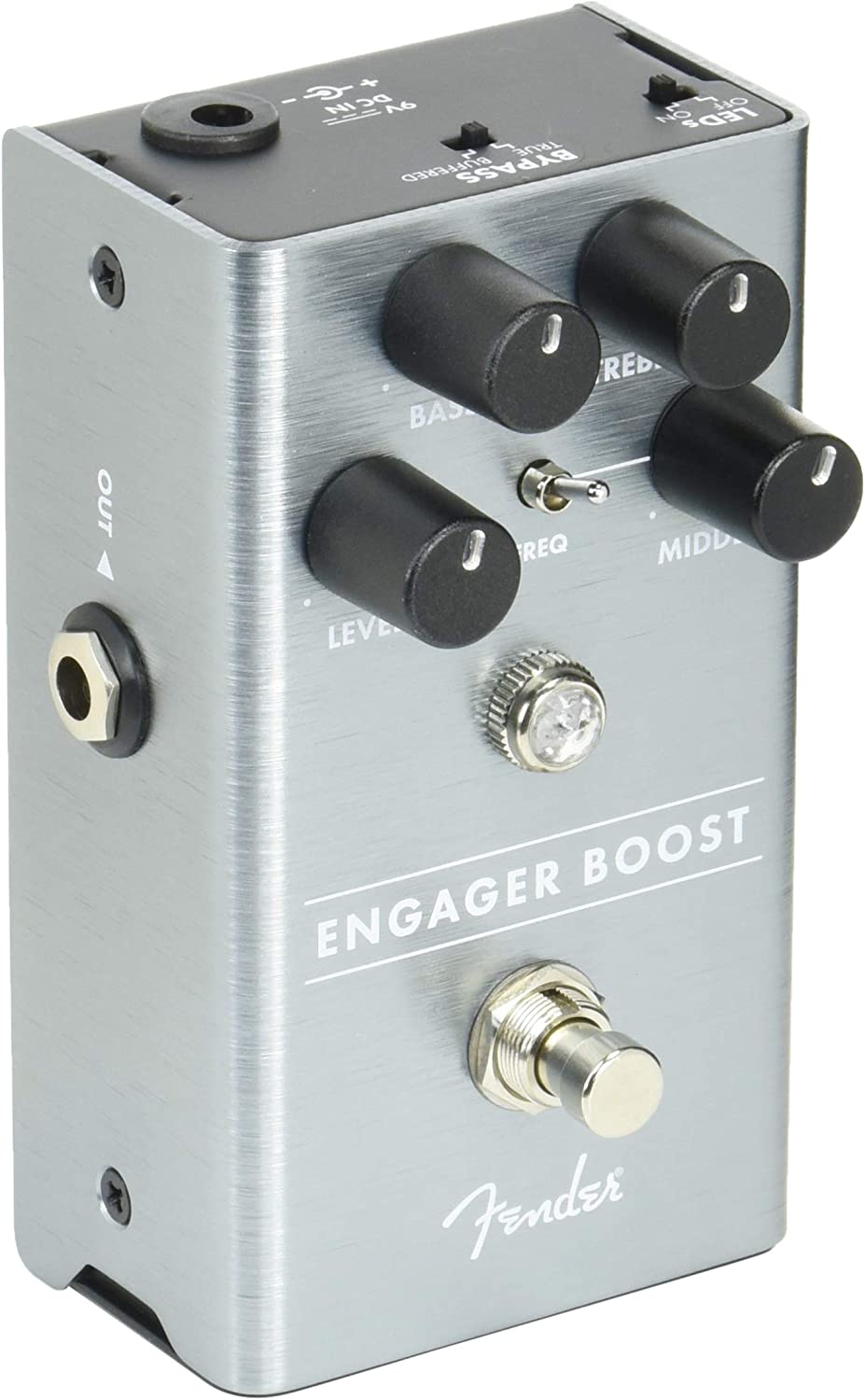
The Fender Engager Boost Pedal is designed to elevate your sound.
This clean boost effect pedal can amplify your volume or enrich your tone, depending on your desire.
What makes this gadget unique is its 3-band EQ onboard, enabling you to tailor your tone and allow it to stand out in any mix.
A particularly interesting feature is the frequency switch, ideal for fine-tuning your sound.
Moreover, this pedal can also enhance your signal into a tube amplifier’s preamp, adding thickness to your tone.
Thanks to its true and buffered bypass modes, it is designed to work well in any rig.
Convenience is key with this pedal, featuring LED-illuminated knobs that show your settings clearly, even on dimly lit stages.
It’s not just about functionality; durability also comes into play.
Crafted from lightweight, anodized aluminum, this pedal can handle the wear and tear of touring.
Plus, the magnetically latched 9V battery door simplifies battery changes.
Designed by a team of in-house experts, the Fender Engager Boost Pedal has been constructed considering the player’s needs.
- My Review
After spending quality time with the Fender Engager Boost Pedal, it’s evident how much thought has gone into its design.
Let’s start with the core function – the clean boost.
It’s impressively versatile.
You can achieve a richer tone or a considerable volume boost, making it a handy tool for guitarists.
It doesn’t stop there, though.
With the 3-band EQ onboard, there’s a lot of tonal shaping at your disposal.
Tailoring the sound to cut through any mix is straightforward and effective.
A standout feature is the frequency switch.
Tuning the middle-frequency range with such precision is truly beneficial.
It adds another layer of control over your sound.
I’ve found this particularly useful when experimenting with different soundscapes.
One impressive aspect is the ability of this pedal to enhance the signal into a tube amplifier’s preamp, adding thickness to the tone.
This attribute is commendable and results in a warm, robust sound pleasing to the ears.
As for compatibility, this pedal fits into any rig, thanks to its true and buffered bypass modes.
These features ensure the pedal’s seamless integration, no matter the setup.
The Engager Boost Pedal doesn’t skimp on convenience.
LED-illuminated knobs make it easy to see your settings, even on a dimly lit stage.
And there’s something truly satisfying about the easy-swap, magnetically latched 9V battery door.
Durability is another noteworthy aspect.
The pedal’s lightweight, anodized aluminum construction can withstand touring demands.
In addition, it feels solid underfoot, giving confidence in its longevity.
Here are the ratings I’ll give to the Fender Engager Boost Pedal:
While I applaud the in-house design team for their thoughtful creation, I wish there was more room between the control knobs.
Nevertheless, the Fender Engager Boost Pedal is an essential gear addition, designed with purpose and delivering performance.
- Pros:
- Clean boost effect.
- Onboard 3-band EQ.
- True and buffered bypass modes.
- LED-backlit knobs.
- Cons:
- Relatively large item dimensions (6 x 4 x 6 inches).
- Lightweight construction may be less durable.
My final verdict is that the Fender Engager Boost Pedal is a highly versatile and feature-rich pedal that delivers a clean boost and precise tone-shaping capabilities.
It performs well and showcases the quality associated with the Fender brand.
While its larger dimensions may be a minor drawback, the lightweight construction could affect its durability.
Considering its features, performance, brand reputation, and value, the Fender Engager Boost Pedal is a solid choice for musicians seeking a reliable boost pedal for their rig.
TC Electronic SPARK Mini Booster Pedal
Boost your playing with TC Electronic’s SPARK MINI BOOSTER’s 20 dB of clean boost.
SPARK MINI BOOSTER is an ultra-compact booster pedal with PrimeTime switching and all-analog design, offering up to 20 dB of boost with a revolutionary feature for permanent and momentary on/off switching. It’s designed to enhance your tone without any coloration, delivering maximum musical potential with a magical sense of life and excitement.
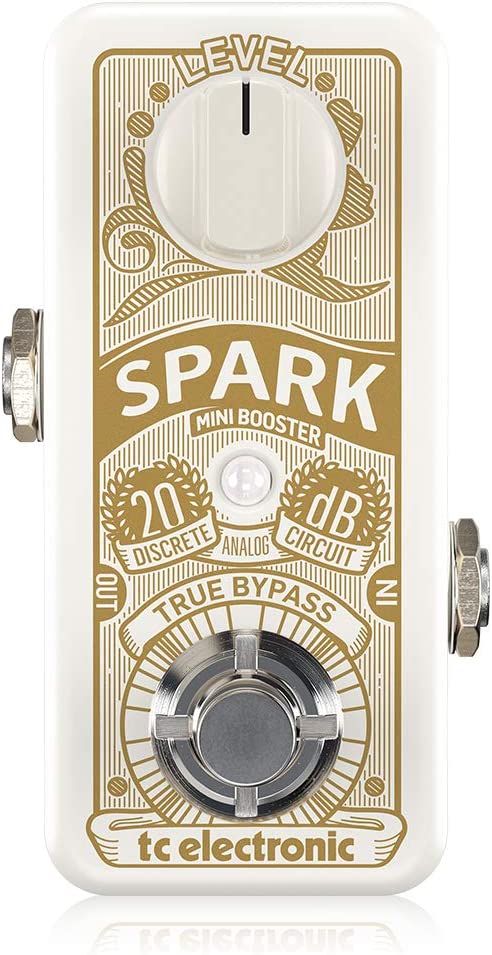
Meet the TC Electronic SPARK MINI BOOSTER, a game-changer in ultra-compact booster pedals.
Its striking all-analog design has an innovative PrimeTime switching mechanism that enhances performance.
This pedal is designed to sense your needs based on the duration of your footswitch hold, providing you with a momentary or classic on/off boost.
With an impressive 20 dB boost capability, your core sound will remain pure and powerful without distortion or coloration.
The pedal sports a single Level control knob, giving you the flexibility to achieve a pure boost or drive your amps to their utmost capability.
An entirely analog circuit ensures your signal’s integrity, amplifying it without degradation.
TC Electronic makes this multi-colored stompbox and comes in standard style, measuring 3.66 x 2.01 x 1.81 inches and weighing just 0.16 kilograms.
This is one pedal that truly lives up to its rebel spirit.
- My Review
Stepping on the TC Electronic SPARK MINI BOOSTER, I was welcomed by a surprising surge in volume and clarity.
It’s like a magic wand that uncovers the hidden potential of your sound.
And even with the notable 20 dB boost, it’s striking how there’s no distortion or any other alterations to my core tone—just pure, powerful sound.
What impressed me, even more, was the thoughtful PrimeTime switching feature.
This pedal isn’t just about “all-on or all-off.” No, it goes beyond that.
It’s like it now understands my needs, distinguishing between a quick tap for an all-out boost or a longer press when I need a little extra push.
The single Level control knob might initially seem limited, but don’t be fooled.
It’s the pedal’s very simplicity that lends itself to such versatility.
With a smooth twist of the knob, I can go from a subtle boost to driving my amp into satisfyingly rich overdrive.
It’s an inspiring tool that pushes the boundaries of my performance.
However, it’s not all sunshine and rainbows.
While great for preserving signal quality, I noticed that the all-analog design is less effective regarding noise reduction.
So it might be a slight annoyance, especially if you’re a stickler for a noiseless setup.
In terms of build and design, I can’t fault it.
Compact and lightweight, it hardly takes up any space on my pedalboard.
The SPARK MINI BOOSTER is built with the on-the-go musician in mind.
This sturdy little stompbox is ready to withstand all the rigors of the road.
Here are the ratings I’ll give to the TC Electronic SPARK Mini Booster Pedal:
While it won’t replace a multi-effects unit or a more specialized boost pedal, the TC Electronic SPARK MINI BOOSTER is a solid piece of gear that offers great value and impressive sound enhancement.
It’s a pedal I’d happily add to my setup, ready to spark up my sound whenever needed.
- Pros:
- Very clean boost
- Small footprint
- Flexible with different setups
- No coloration of tone
- Instant boost with PrimeTime switching
- Cons:
- Occasional crackling noise
- Switch produces popping sound
- May not increase volume of distorted sound
- Some quality issues reported
- Not suitable for all musical styles
My final verdict is that the TC Electronic SPARK MINI BOOSTER is a versatile and feature-packed pedal that delivers exceptional tone and performance.
Its clean boost, PrimeTime switching, and analog circuitry enhance your playing experience and allow your core tone to shine through.
The positive reviews highlight its effectiveness and value for the price.
However, some occasional quality issues and functionality concerns are reported by a few users.
Considering its strengths and weaknesses, I recommend the SPARK MINI BOOSTER for those seeking a compact and reliable boost pedal to elevate their guitar playing.
What exactly is a boost pedal?
A boost pedal is an essential piece of hardware that can provide significant utility in a musician’s toolkit, especially for guitarists.
This device acts to amplify the signal coming from a guitar, elevating the overall output without altering the intrinsic tonal characteristics of the instrument.
It can be seen as a transparent enhancement of a guitar’s sound, allowing for greater volume and expression diversity.
However, like many aspects of music, a boost pedal’s precise utilization and impact can vary significantly depending on the artist’s preferences and the specific context in which it’s used.

At its most fundamental level, a boost pedal increases the signal level sent to an amplifier.
Naturally, this results in a louder sound, but importantly, it doesn’t introduce any additional distortion or coloration.
A boost pedal is designed to be sonically transparent, providing more of what’s already there.
This differentiates it from an overdrive, distortion, or fuzz pedal, which purposefully colors the tone or adds grit to the sound.
A boost pedal’s benefit becomes evident when used in conjunction with a tube amplifier.
Tube amps create a natural, warm, overdrive tone when driven hard.
Using a boost pedal you can drive the signal into the tube amplifier, causing the tubes to clip and produce a natural overdrive that’s highly sought after by many guitarists.
This way, a boost pedal can indirectly create distortion, not by its circuitry, but by pushing the amp harder.
Another use for a boost pedal is to increase volume for solos or specific parts of songs.
For example, when playing with a band, guitarists often need to raise their volume during a solo to stand out from the other instruments.
Using the volume knob on the guitar can affect the tone, and it’s not always practical to adjust the amplifier’s settings mid-song.
In such a situation, a boost pedal is a practical solution.
By stepping on the boost pedal, the guitarist can increase their volume instantly and decrease it when the solo or the highlighted part is over.
In a broader context, a boost pedal can also be used to hit other effects pedals harder.
For example, some pedals, like fuzz or overdrive, respond differently depending on the strength of the incoming signal.
By placing a boost pedal before such pedals in the signal chain, you can change their response and potentially unlock new tones.
While a boost pedal seems like a simple device, there are still variations in designs and functionalities across different models.
For example, some pedals provide a flat boost, amplifying all frequencies equally.
Others, often called treble or bass boosters, selectively amplify certain frequency ranges.
Certain pedals might also offer the ability to shape the EQ (equalization) curve, further enhancing its versatility.
Furthermore, the simplicity of a boost pedal lends itself to experimentation.
It can be used in various places in the signal chain, before or after other effects pedals, and the impact can be different each time.
Therefore, while the primary function of a boost pedal is straightforward, its potential uses are wide-ranging.
What to consider when choosing a boost pedal?
Choosing a boost pedal can be crucial in defining your guitar tone, and finding the right one can take your sound to the next level.
To make the right choice, you need to consider various factors, and here are some crucial ones.
– Sound quality
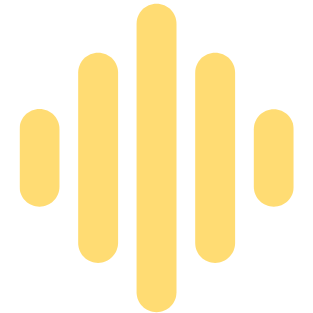
Sound quality is the primary consideration when selecting a boost pedal or musical equipment.
The purpose of a boost pedal is to amplify your guitar signal without distorting or coloring it.
However, each boost pedal imparts a different character to the sound, even if subtly.
Some are more transparent, while others add a bit of warmth or color to the tone.
Therefore, pay attention to the tonal characteristics and the overall quality of sound the pedal produces.
Test different boost pedals with your own guitar and amplifier setup if possible since the final output results from this triadic interaction.
– Controls and features

Boost pedals come in various designs, from minimalist pedals with just one knob for volume to complex models with various tone-shaping controls.
Depending on your requirements, you might prefer a simple design for easy usage or a more intricate one for better control over your sound.
Some boost pedals offer features like EQ controls, dual channels, or built-in tuners.
These features can add to the pedal’s versatility, but they can also add to the complexity and the price.
– Analog vs. Digital

Boost pedals can be analog or digital, each with unique qualities.
Analog boost pedals provide a warmer, more natural sound than many guitarists prefer.
They use analog circuits to amplify the signal and are prized for their tonal richness and harmonic complexity.
Digital boost pedals, on the other hand, process the signal digitally.
While they might not have the ‘analog warmth,‘ they offer more consistency and might include additional features like programmability and preset storage.
The choice between analog and digital often boils down to personal preference and the specific needs of your setup.
– Build quality and durability

The build quality of a boost pedal is crucial, especially if you’re going to use it for live performances.
It needs to withstand heavy foot action and the rigors of touring.
So look for pedals with sturdy enclosures, durable switches, and well-constructed knobs.
A well-built pedal will not only last longer, but it’s also likely to offer more consistent performance.
– Presets and versatility

The more versatile a boost pedal is, the more situations it can be used in.
For example, some boost pedals have preset slots that let you save and recall different settings.
This feature can be particularly useful in live settings, allowing you to switch between different volume levels or EQ settings on the fly.
Using the pedal in different contexts, such as before or after other effects in the signal chain, can also add to its versatility.
– Brand Reputation

While the brand shouldn’t be your only consideration, it can be a useful indicator of the pedal’s quality and reliability.
Renowned brands often have stringent quality control procedures and provide better customer support.
Additionally, countless musicians have road-tested popular brands, giving you a better idea of what to expect.
– Price and budget

As with any purchase, you need to consider the price of the boost pedal and your budget.
While higher-priced pedals often offer better sound quality and more features, many affordable models offer great value.
It’s important to find a balance between the pedal’s price and the value it provides.
Spending more doesn’t necessarily mean you’re getting a better pedal.
Sometimes, a less expensive pedal might serve your needs just as well.
– Reviews and recommendations

Lastly, consider reviews and recommendations from other musicians, especially those whose opinions you trust and who play in a similar style.
Reviews can provide valuable insights into the pedal’s real-world performance that you can’t get from product descriptions.
Consider both professional and user reviews, but remember to take each review with a grain of salt, as different people have different preferences and experiences.
How to properly use a boost pedal?
Proper use of a boost pedal can elevate your guitar playing, bringing depth and versatility to your sound.
However, if you want to amplify your sound, achieve a sweet overdrive, or improve the response of other effects, it’s crucial to understand the dynamics of using a boost pedal.
– Familiarize yourself with the controls and features
The first step to properly using a boost pedal is understanding its features and controls.
A typical boost pedal will have a volume or level control, allowing you to set the amount of boost.
Some models may have additional controls like EQ or tone knobs that let you shape the tone further.
Please read the manual to understand what each control does and how it affects the sound.
Then, explore different settings to get a feel for the pedal’s capabilities.
– Adjust the parameters to suit your musical goals
After familiarizing yourself with the controls, adjust the parameters to align with your musical objectives.
For example, if you’re using the boost for solos, you might want to set a significant volume boost to make your guitar stand out.
If you’re using it to drive your amp into overdrive, experiment with different boost levels to find the sweet spot where it starts to break up.
This will vary depending on the guitar, pickup, and amp you’re using, so listening and adjusting are essential.
– Incorporate the boost pedal into your signal chain
Where you place the boost pedal in your signal chain can drastically change its effect.
If you place it at the beginning of your chain, it can drive your guitar signal harder into the rest of your effects and amp, resulting in a more pronounced effect from all following pedals and a more robust sound from your amp.
Placing it at the end of the chain will elevate the signal level processed by all the previous pedals.
This placement is generally more suited for increasing volume without significantly altering the tone.
Experiment with different placements in your chain to see which works best for your setup.
– Utilize the pedal to achieve specific tonal effects
A boost pedal can be a potent tool for achieving various tonal effects.
For example, you can use it to add sustain to your notes by driving the amp harder.
The increased signal level can cause the amp to compress the sound, which results in longer sustain.
You can also use a boost pedal to enhance the response of your tube amp.
By driving the tubes harder, you can achieve a natural, harmonic-rich overdrive that’s impossible with just the amp’s gain control.
– Combine with other effects pedals for enhanced textures
A boost pedal can also be combined with other effects pedals to create more complex tones.
You can push these pedals harder and change their tone by placing a boost pedal before a fuzz or distortion pedal.
Or you can place it after a delay or reverb pedal to increase the effect level without altering your guitar’s dry signal.
There’s no hard and fast rule here, so don’t be afraid to experiment and find combinations that work for you.
– Practice playing dynamics with the boost engaged
A boost pedal can significantly affect your playing dynamics.
The increased signal level can make your playing sound more aggressive when you engage the boost.
It’s essential to practice playing with the boost engaged in learning how it responds to your playing dynamics.
You may need to adjust your picking or strumming strength to achieve the desired sound.
– Maintain and troubleshoot your boost pedal for optimal performance
Like all gear, a boost pedal needs proper care and maintenance for optimal performance.
Regularly clean the pedal to remove dust and grime.
Check the connections and ensure the cables and jacks are in good condition.
If you encounter issues like a noisy signal or sudden volume drop, check the battery or power supply, as these are common sources of problems.
If the issue persists, you may need to consult a professional.
How to order pedals on a pedalboard?
There is no one-size-fits-all approach to ordering pedals on a pedalboard, as the optimal arrangement largely depends on the specific sound you’re aiming for.
Usually, though, you will see guitar players mostly agreeing with this order:
Tuner > Filters/Dynamics > Pitch-based Effects > Overdrive/Distortion > Modulation > Time-based Effects > Looper
Aside from that, some general guidelines can help you achieve a balanced and versatile setup.
Let’s talk in detail about the order we just mentioned, but feel free to experiment and adjust to your own preferences:
- Tuner: Place your tuner pedal first to ensure your signal is in tune before passing through the other pedals.
- Filters and dynamics: Wah-wah, envelope filters, compressors, EQs, and noise gates should come next. These pedals affect your sound’s dynamic and tonal aspects, so it’s best to place them early in the chain.
- Pitch-based effects: Octavers, harmonizers, and pitch shifters should come after filters and dynamics since these pedals alter the pitch of your signal and work best with a clean, unprocessed sound.
- Overdrive and distortion: Overdrive, distortion, and fuzz pedals typically come next. They shape your guitar’s core sound, and placing them before most other effects ensures that those effects receive a strong, consistent signal.
- Modulation effects: Chorus, flanger, phaser, and tremolo pedals should be placed after overdrive and distortion effects. We do this to allow these pedals to add depth and movement to your sound without becoming overly distorted or overbearing.
- Time-based effects: Delay and reverb pedals should be placed towards the end of your signal chain. This allows them to create a sense of space and depth around the other effects, simulating the sound of a room or hall.
- Looper: If you use a looper pedal, it should be placed last in the chain. This ensures that you’re looping the entire signal, including all the effects you’ve applied.
Remember, these are just general guidelines and what generally works and sounds good.
The most important thing is to experiment and find the arrangement that best suits your personal sound and style.
For example, here’s one pedalboard signal chain that I always use:
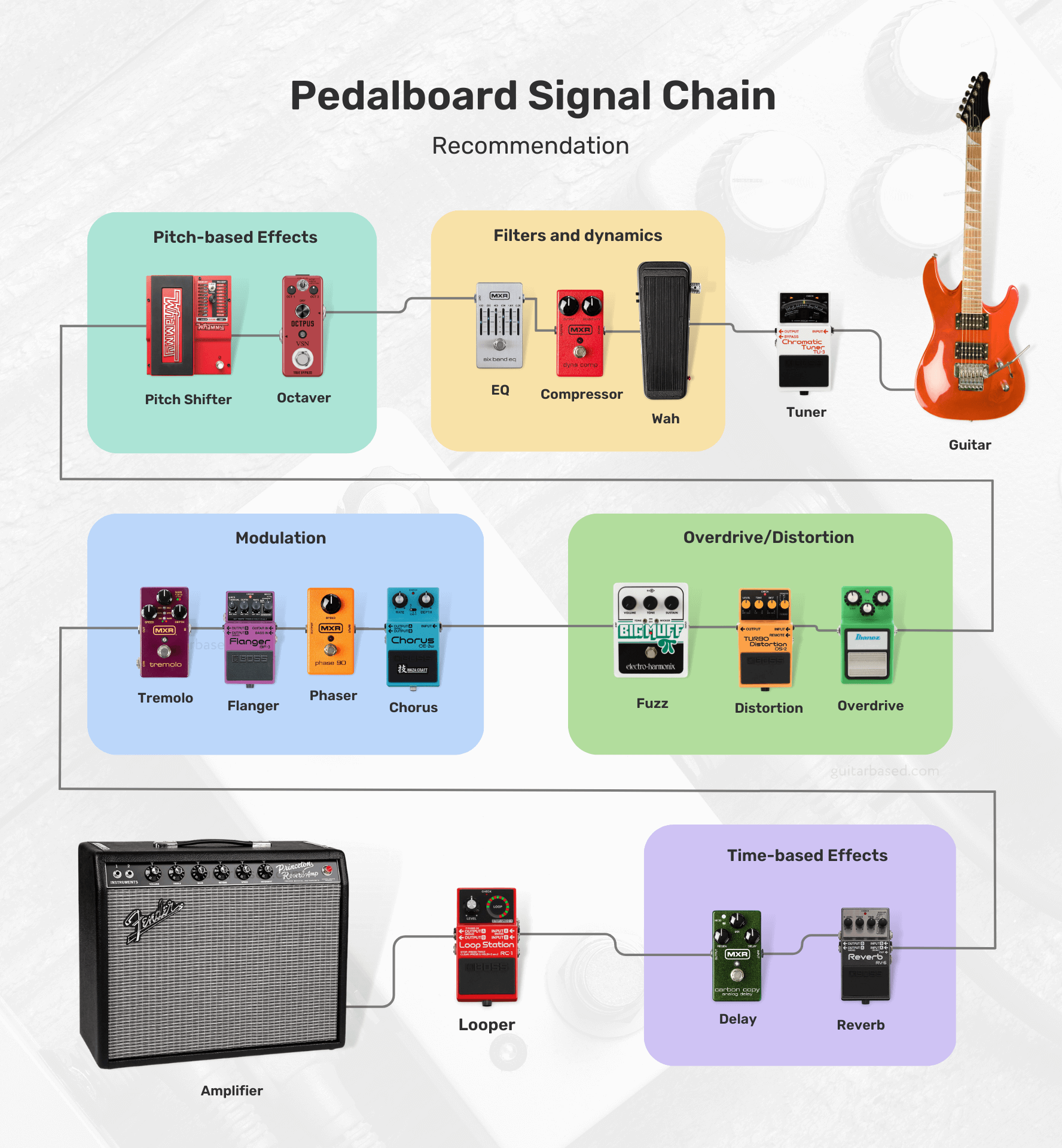
Feel free to swap the order of pedals, try different combinations, and test out unconventional setups until you find the one that works best for you.
For those interested, I’ll leave you with most of the possibilities that you’ll encounter and how to order them.
- Tuner
- Filters/Dynamics:
- Volume
- Wah
- Auto-Wah
- Compressor
- Noise Gate
- EQ (Equalizer)
- Pitch-based Effects:
- Octaver
- Harmonizer
- Pitch Shifter
- Overdrive/Distortion/Fuzz:
- Boost
- Overdrive
- Distortion
- Fuzz
- Modulation:
- Chorus
- Phaser
- Flanger
- Univibe
- Vibrato
- Tremolo
- Time-based Effects:
- Delay
- Echo
- Reverb
- Synth/Bitcrusher:
- Synth
- Bitcrusher
- Acoustic Simulator
- Multi-Effects
- Utility:
- Buffer
- A/B/Y Switcher
- MIDI Controllers
- Looper
Boutique vs. Mass-Produced pedals
Boutique pedals are generally built with higher-quality components and craftsmanship, resulting in better durability and longevity.
These pedals often feature unique and innovative designs, providing a wider range of tones and effects that may not be available in mass-produced options.
Here are a few examples of boutique pedals:

All the manufacturers also tend to have a more personal approach, with better customer service and the ability to customize pedals according to the user’s preferences.
However, boutique pedals are usually more expensive due to the smaller scale of production and the use of premium components.
Mass-produced pedals, on the other hand, are more affordable due to their larger scale of production and the use of cost-effective components.
These pedals are widely available and offer a range of popular effects, making them accessible to a larger audience.
Here are a few examples of mass-produced pedals:

The quality control for mass-produced pedals can vary depending on the brand and model, but many are reliable and offer good value for the money.
As for one of the downsides, you’ll find that mass-produced pedals may not have the same level of uniqueness or innovation as boutique options.
On the other hand, they may not provide the same level of customer service or customization options.
The choice between boutique and mass-produced pedals depends on your personal preferences, budget, and desired sound.
If you’re looking for unique tones, higher-quality components, and a more personal experience, boutique pedals may be the way to go.
But I would say, for those who are on a budget and need access to popular effects, mass-produced pedals might be a better fit.
It’s worth trying out both types to see which best suits your needs and playing style.
How much should you spend on a guitar pedal?
If I were in your position, I would first determine my budget and specific needs before deciding how much to spend on a guitar pedal.
For beginners, it might be more reasonable to start with affordable, mass-produced pedals to explore different effects without spending too much.
Guitar pedals can range in price from around $30 to over $400, depending on the brand, quality, and complexity of the effect.
As your skills and understanding of your preferred tone develop, you can gradually upgrade to higher-quality or boutique pedals.
One thing I would do is consider which effects are essential to your playing style and prioritize purchasing those first.
Allocating a larger portion of your budget to the most important pedals might be a wise choice, especially if you only need a few basic effects.
However, if you require a wide array of effects, you may want to consider more budget-friendly options or multi-effects units.
Keep in mind that higher-priced pedals often come with better build quality, unique features, and improved sound quality.
But I would also say that price is not always directly correlated with quality or suitability for your needs.
Sometimes, a more affordable pedal can deliver the exact sound you’re looking for, while a higher-priced option might not meet your expectations and are only expensive because of the brand reputation.
Can you use a guitar pedal with a bass guitar?
You can certainly use a guitar pedal with a bass guitar.
But it’s crucial to be aware that some guitar pedals may not be specifically designed to accommodate the frequency range of a bass guitar.
This could result in a less-than-ideal performance or an altered tone that might not be what you were expecting.
If you’re feeling adventurous and eager to experiment with your sound, don’t hesitate to connect your guitar pedals to your bass guitar.
This can be a fun way to explore different sonic possibilities, and you might even stumble upon some unique tones that complement your playing style perfectly.
Using a guitar pedal with a bass guitar may not always produce the desired results.
In some cases, the low-end frequencies might be lost, or the effect could sound too harsh or muddy.
To avoid these issues, you could consider looking into pedals that are specifically designed for bass guitars.
These pedals are engineered with the bass frequency range in mind, ensuring that your low-end remains intact and the effect sounds as intended.
In addition to bass-specific pedals, there are also multi-effects processors and pedals that cater to both guitar and bass players, offering a wide range of effects and tonal options.
These versatile units can be a great solution if you play both instruments and want a single device to cover your needs.
How to properly power your pedals?
When it comes to powering your pedals, you want to make sure you’re doing it right to avoid any noise issues or potential damage.
First, check each pedal’s power requirements, which you can usually find in the manual or on the pedal itself.
You’ll want to pay attention to the voltage (usually 9V, 12V, or 18V) and current (measured in milliamps or mA).
Now, you’ve got a few options for powering your pedals.
You can use individual power supplies or batteries for each pedal, but that can get messy and inconvenient.
I’d recommend going for a pedal power supply or an isolated power brick.

For example here are a few ones I recommend:
- Voodoo Lab Pedal Power 2 Plus Isolated Power Supply (My favorite)
- Rowin PW-1 Guitar Pedal Power Supply (Cheapest)
These babies can power multiple pedals at once, and the isolated outputs help prevent noise and ground loop issues.
Just make sure the power supply you choose can handle the voltage and current requirements of all your pedals.
When you’re connecting everything, use good quality power cables and keep them neat and tidy to avoid a tangled mess.
You might even want to use cable ties or cable organizers to keep everything in order.
In love with guitars, and gear; expert in all things music! Been writing about guitars for about 5 years and counting. Born in the ’90s. Alma Mater: University of Havana. Always curious, trying to understand the world. #TeamFender

